COLEÇÃO
Joan Miró

Sonic Rotating Geometry Type F - Nickel Plated # 19
Haegue Yang (Seoul, Coreia do Sul, 1971)
Steel sheet, powder coating, ball bearings, metal grid, nickel plated bells, metal rings
70 x 70 cm
Coll. Fundação de Serralves - Museu de Arte Contemporânea, Porto, Portugal. Acquisition 2014
The four 'Sonic Rotating Geometries', part of a series begun in 2013, propose an overlay of formal and conceptual narratives. The interplay of geometry, colour, motion and sound is one of their essential components. Mounted directly onto a monochrome circular background painted on the wall, these geometric shapes are covered with nickel-plated bells that can be set in rotation by hand. The colours are selected from the palette of the decorative scheme designed in 1926-28 by Sophie Taeuber-Arp with Hans Arp and Theo Van Doesburg for the Salle des Fêtes and the Foyer Bar of the Aubette building in Strasbourg. With movement, these abstract forms are dissolved into a blurred geometry that recalls the optical illusions of Marcel Duchamp's 'Rotoreliefs' (1935). Yet in Yang's work, the visual effect is replaced by the oscillations of the bells, associated with Buddhist chimes or shamanist ceremonies. Bells are a recurring element in her recent work, in which sculpture becomes a presence that is pushed, pulled, worn or inhabited, creating resonating combinations of movement, light and sound.Haegue Yang’s sculptural propositions are part of a multivalent form of art making comprising a graphic as well as a sculptural oeuvre, and in which exhibition display itself constitutes a vital and choreographed dimension. Sound, movement, found objects and ready-made structures, such as clothing racks, venetian blinds and electric lamps and fans, have constituted the material for her physical environments and totem-like sculptures that suggest transience and evocations of mobility across time and space. In recent years, Yang has looked to the canon of modernist art, dance and costume design, from the Aubette designs, to Stravinksy’s The Rite of Spring of 1910 and The Triadic Ballet, designed by Bauhaus teacher Oskar Schlemmer in 1922.

Sonic Rotating Geometry Type D - Nickel Plated # 16
Haegue Yang (Seoul, Coreia do Sul, 1971)
Steel sheet, powder coating, ball bearings, metal grid, nickel plated bells, metal rings
100 x 100 cm
Coll. Fundação de Serralves - Museu de Arte Contemporânea, Porto, Portugal. Artist's donation 2014
The four 'Sonic Rotating Geometries', part of a series begun in 2013, propose an overlay of formal and conceptual narratives. The interplay of geometry, colour, motion and sound is one of their essential components. Mounted directly onto a monochrome circular background painted on the wall, these geometric shapes are covered with nickel-plated bells that can be set in rotation by hand. The colours are selected from the palette of the decorative scheme designed in 1926-28 by Sophie Taeuber-Arp with Hans Arp and Theo Van Doesburg for the Salle des Fêtes and the Foyer Bar of the Aubette building in Strasbourg. With movement, these abstract forms are dissolved into a blurred geometry that recalls the optical illusions of Marcel Duchamp's 'Rotoreliefs' (1935). Yet in Yang's work, the visual effect is replaced by the oscillations of the bells, associated with Buddhist chimes or shamanist ceremonies. Bells are a recurring element in her recent work, in which sculpture becomes a presence that is pushed, pulled, worn or inhabited, creating resonating combinations of movement, light and sound.Haegue Yang’s sculptural propositions are part of a multivalent form of art making comprising a graphic as well as a sculptural oeuvre, and in which exhibition display itself constitutes a vital and choreographed dimension. Sound, movement, found objects and ready-made structures, such as clothing racks, venetian blinds and electric lamps and fans, have constituted the material for her physical environments and totem-like sculptures that suggest transience and evocations of mobility across time and space. In recent years, Yang has looked to the canon of modernist art, dance and costume design, from the Aubette designs, to Stravinksy’s The Rite of Spring of 1910 and The Triadic Ballet, designed by Bauhaus teacher Oskar Schlemmer in 1922.

Sem título
Xana (Lisboa, Portugal, 1959)
Acrylic paint on wood (2 elements)
163 x 38 x 15 cm (elemento azul); 162 x 35 x 22 cm (elemento vermelho)
Coll. Fundação de Serralves - Museu de Arte Contemporânea, Porto, Portugal. Acquisition 1990
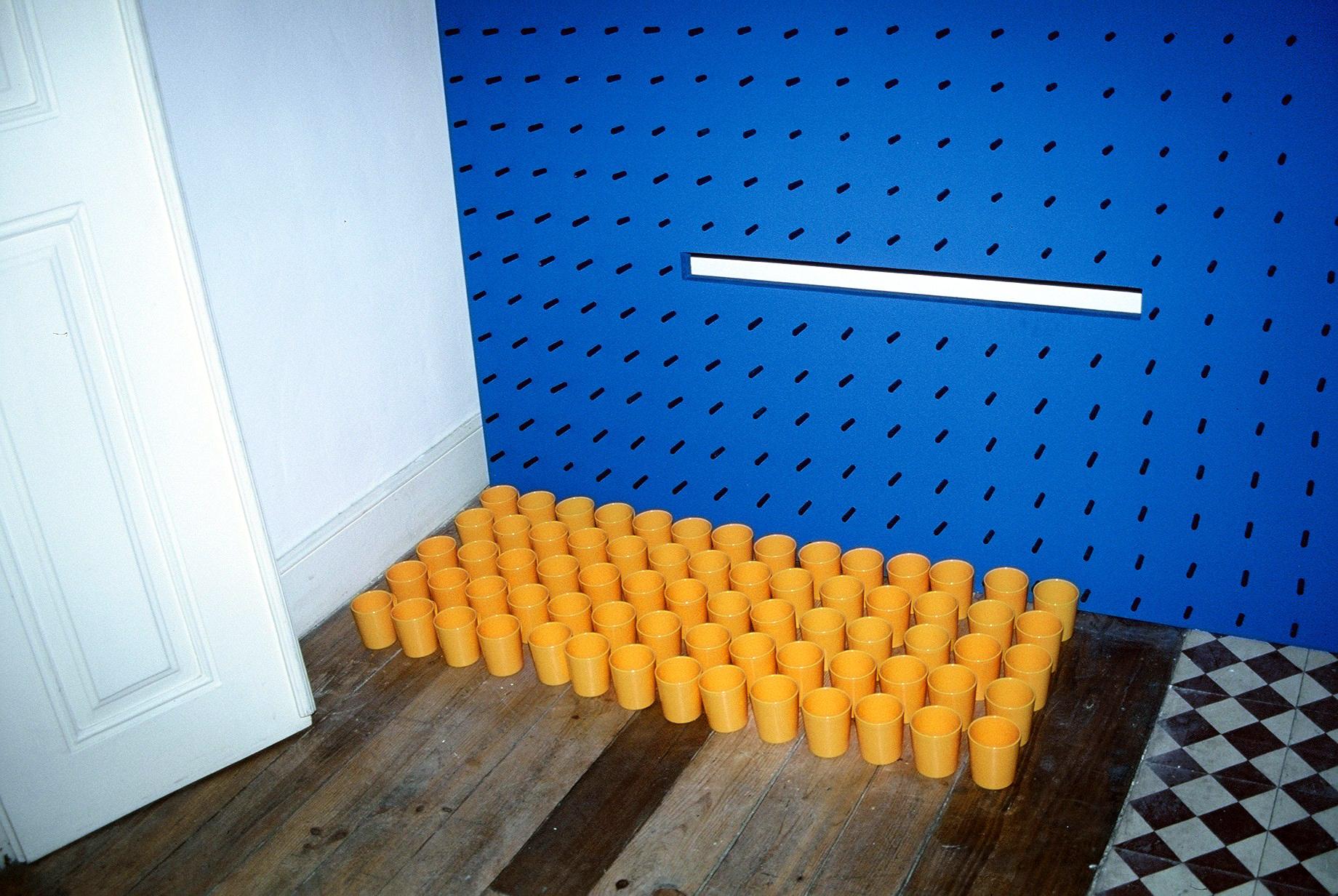
Lar Doce Lar - Na sala - 5
Xana (Lisboa, Portugal, 1959)
Acrylic paint on MDF, painted wood dowels, 72 plastic mugs
205 x 183 x 9 cm
Coll. Ivo Martins, long-term loan to Fundação de Serralves - Museu de Arte Contemporânea, Porto, Portugal. Deposit 1998
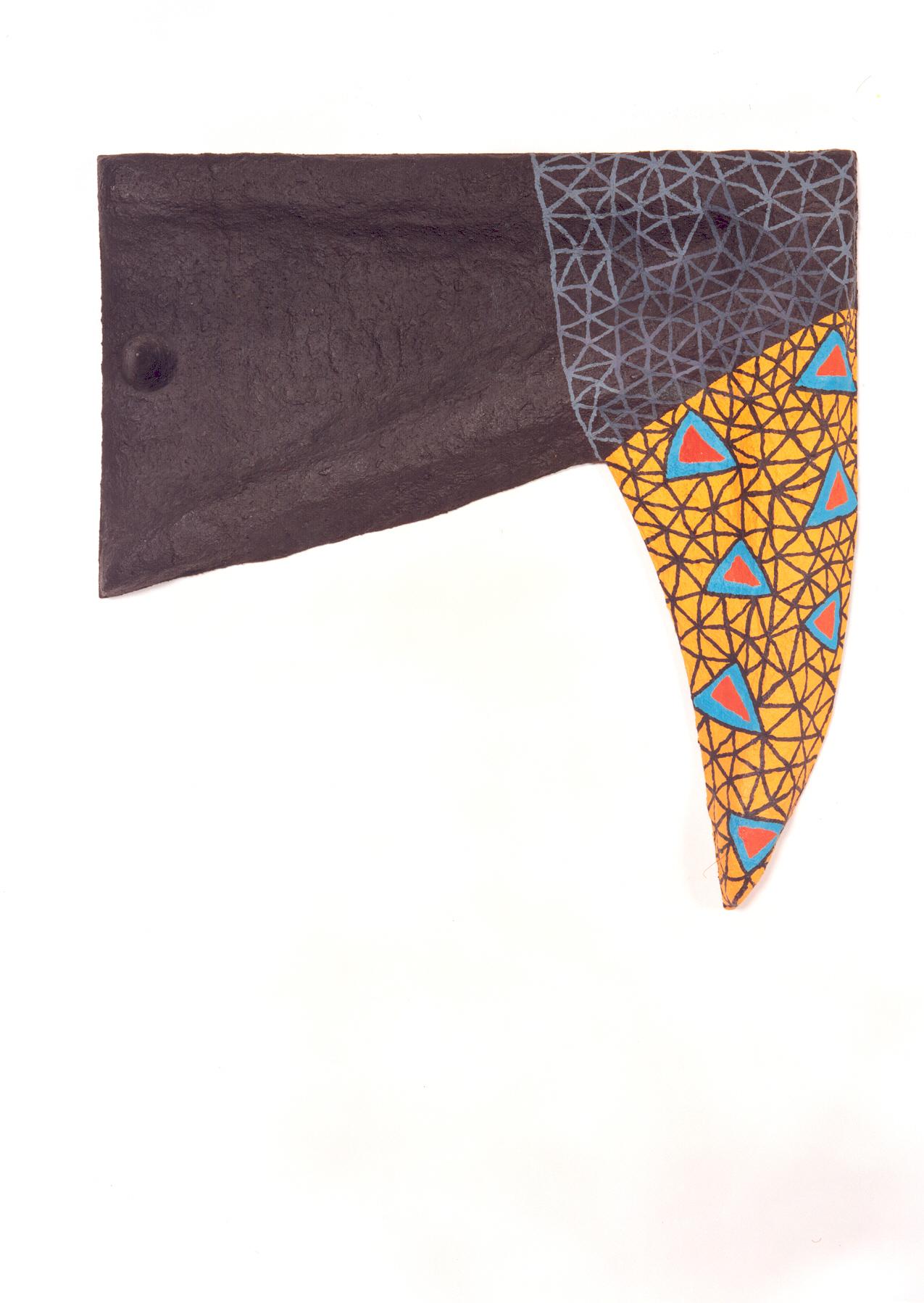
Sem título
Xana (Lisboa, Portugal, 1959)
Acrylic paint on paper paste
61.5 x 61.5 x 7 cm
Coll. Ivo Martins, long-term loan to Fundação de Serralves - Museu de Arte Contemporânea, Porto, Portugal. Deposit 1995
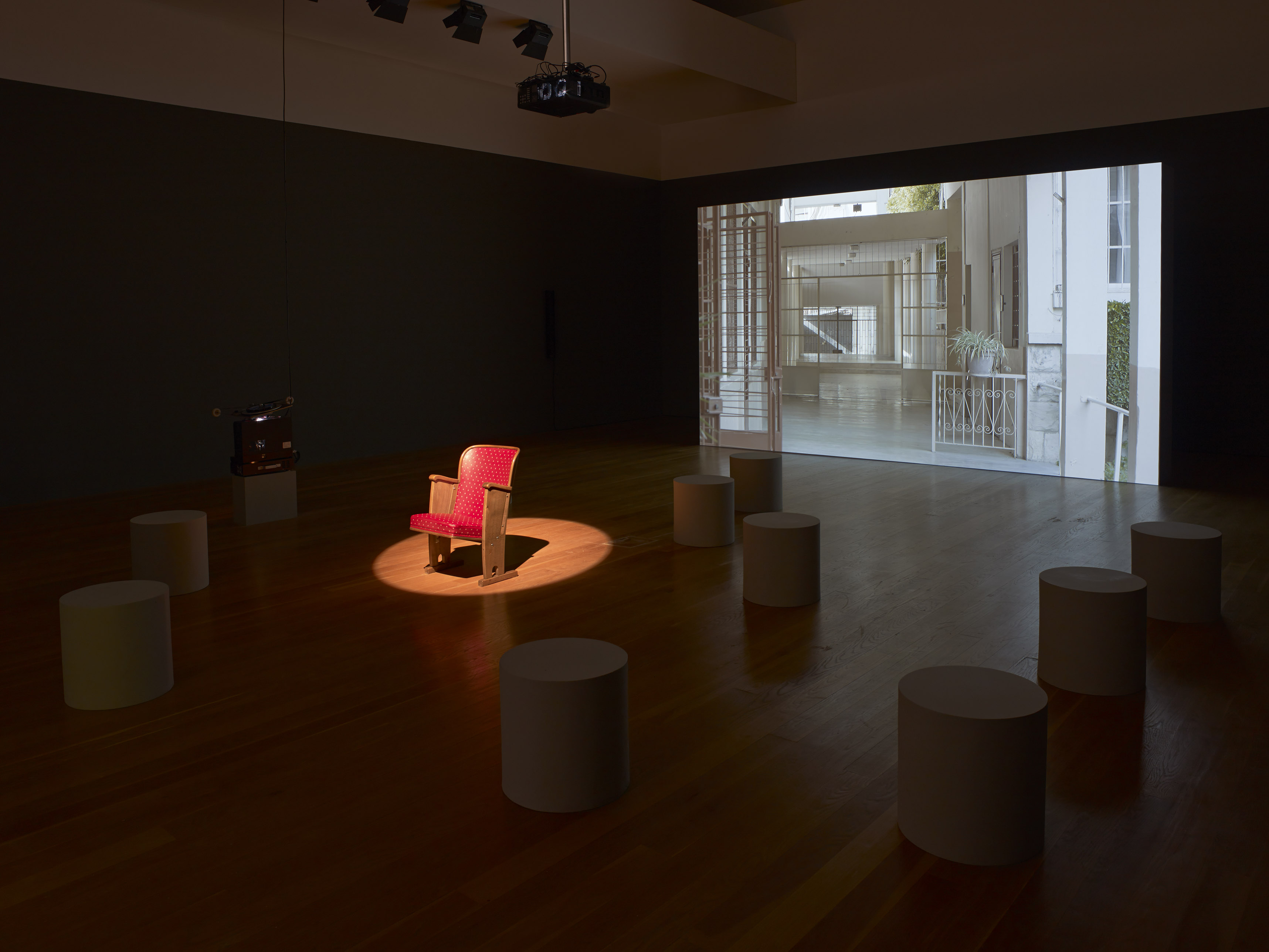
Letter to a Refusing Pilot
Akram Zaatari (Sídon, Líbano, 1966)
HD video (colour, sound, 34’),16 mm loop (colour, silent, 80''), movie theater chair and synchronized light design. Ed. 3/7 + 3 A.P.
Dimensions variable
Coll. Fundação de Serralves - Museu de Arte Contemporânea, Porto, Portugal. Acquisition 2013
'Letter to a Refusing Pilot' (2013) has its origins in a story the artist first heard when he was 16 years old. During the Israeli invasion of Southern Lebanon in 1982, a rumour circulated in Zaatari’s hometown, Saida, that an Israeli fighter pilot was supposed to bomb a target on the outskirts of the city but, aware the building was a school, refused to destroy it. Instead, as the story went, the pilot veered off course and dropped the bombs into the sea. This story of the pilot’s supposed refusal was told over the years with different explanations, as the artist’s own father was the director of the school for twenty years. As Zaatari came to uncover decades later, the story was in fact not a rumour: the pilot was real. In 'Letter to a Refusing Pilot', first presented in the Lebanese Pavilion of the 55th Venice Biennial in 2013, he explores this complex history, weaving personal memory with recent political history, through an installation that places a 45-minute video and a looping 16 mm film, in dialogue within an immersive environment. Much of the work was filmed in the neighbourhood around the school, and incorporates a variety of images, photographs, and drawings, as well as personal documents, to tell the story of the pilot, Hagai Tamir, from the perspective of a teenage boy. The title of the work quotes Albert Camus’s four-part epistolary essay ‘Letters to a German Friend’, revisiting Camus’s plea: ‘I should like to be able to love my country and still love justice’.

Ohne Titel (Passstück)
Franz West (Viena, Áustria, 1947 - Viena, Áustria, 2012)
Epoxy, metal, paint
41 x 41 x 32 cm
Coll. Fundação de Serralves - Museu de Arte Contemporânea, Porto, Portugal. Acquisition 1999
In the 1970s Franz West started to create objects and furniture that were meant for use, such as the sculptures known under the generic heading ‘Passtück’. This word, whose translations vary between ‘adaptive’, ‘fitting pieces’ and ‘parts that fit into each other’, is used to describe a series of works made from found materials and coated in plaster and paint. These pieces are simultaneously sculptures, props and playthings (originally visitors were allowed to handle them as they pleased). Interested in promoting interactive experiences, and in producing objects that only acquire full meaning through their role in actual events, West turned his first viewers into overgrown children, and the ‘Passtück’ into less than innocent playthings: as they tried to adapt the pieces’ shapes to their bodies, exhibition goers revealed all the constraints that prevent people from acting freely.
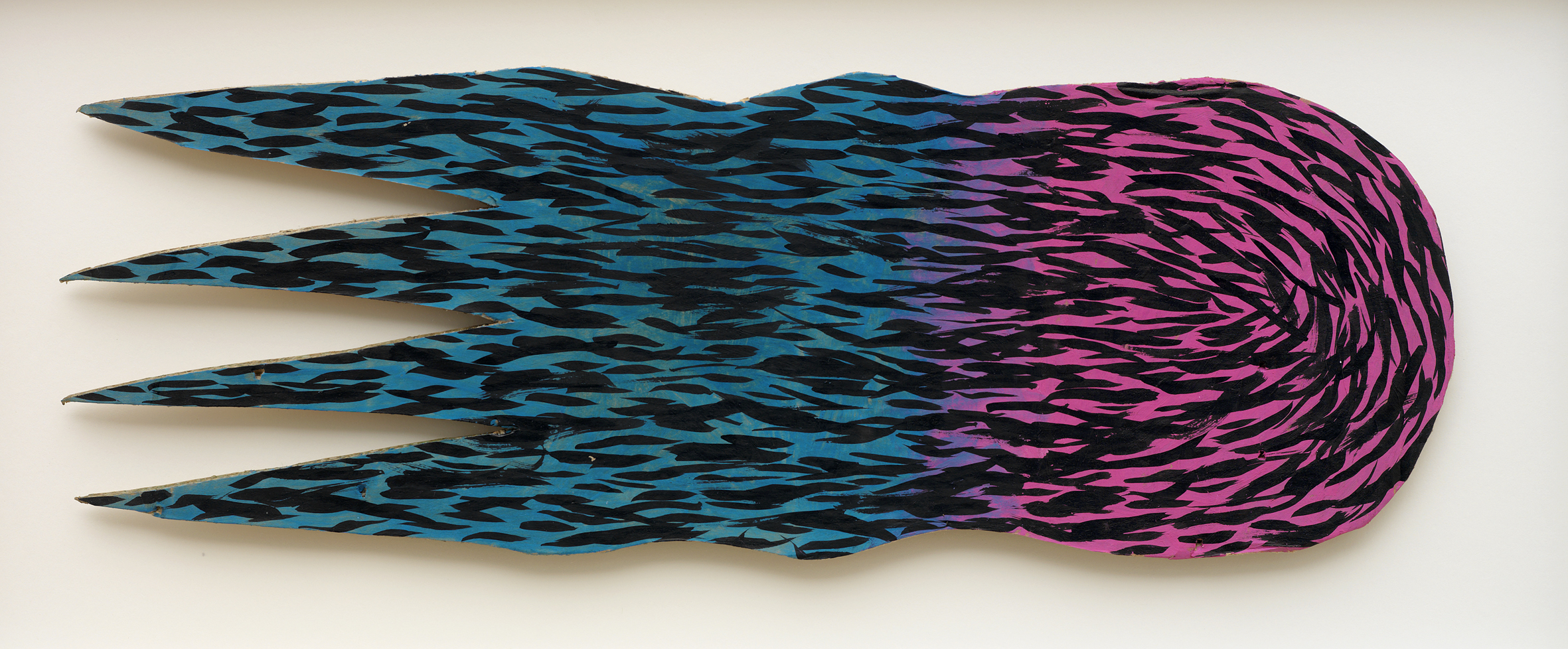
Sem título
Xana (Lisboa, Portugal, 1959)
Acrylic paint on cardboard
17 x 50 cm
Coll. Fundação de Serralves - Museu de Arte Contemporânea, Porto, Portugal. Donation by Fernando Figueiredo dos Santos 2000
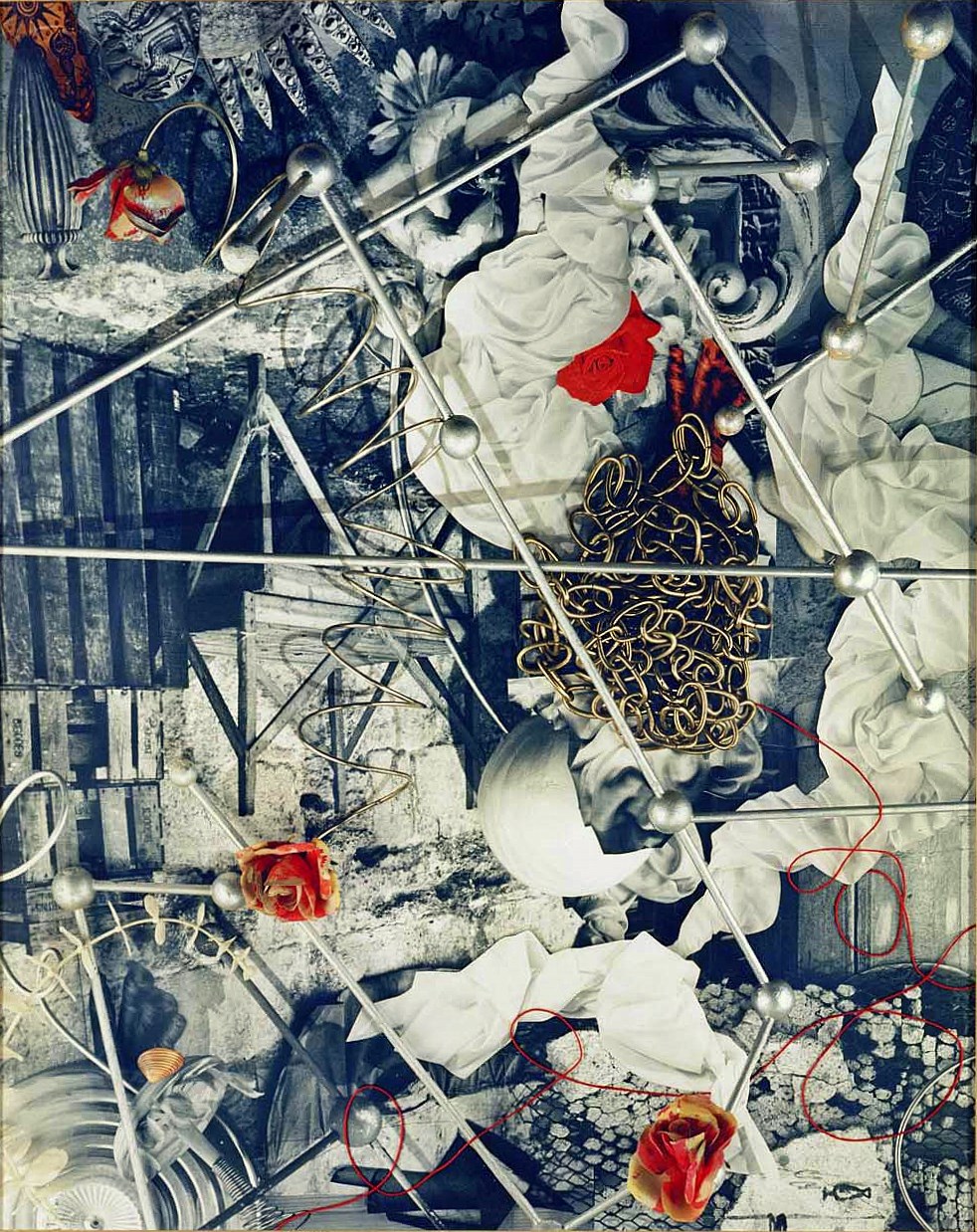
Serie 5 nº8
Amy Yoes (Heidelberg, Alemanha, 1959)
C-print
127.5 x 102 cm
Coll. Fundação de Serralves - Museu de Arte Contemporânea, Porto, Portugal. Acquisition 1990

Sonic Rotating Geometry Type E - Nickel Plated # 18
Haegue Yang (Seoul, Coreia do Sul, 1971)
Steel sheet, powder coating, ball bearings, metal grid, nickel plated bells, metal rings
100 x 100 cm
Coll. Fundação de Serralves - Museu de Arte Contemporânea, Porto, Portugal. Acquisition 2014
The four 'Sonic Rotating Geometries', part of a series begun in 2013, propose an overlay of formal and conceptual narratives. The interplay of geometry, colour, motion and sound is one of their essential components. Mounted directly onto a monochrome circular background painted on the wall, these geometric shapes are covered with nickel-plated bells that can be set in rotation by hand. The colours are selected from the palette of the decorative scheme designed in 1926-28 by Sophie Taeuber-Arp with Hans Arp and Theo Van Doesburg for the Salle des Fêtes and the Foyer Bar of the Aubette building in Strasbourg. With movement, these abstract forms are dissolved into a blurred geometry that recalls the optical illusions of Marcel Duchamp's 'Rotoreliefs' (1935). Yet in Yang's work, the visual effect is replaced by the oscillations of the bells, associated with Buddhist chimes or shamanist ceremonies. Bells are a recurring element in her recent work, in which sculpture becomes a presence that is pushed, pulled, worn or inhabited, creating resonating combinations of movement, light and sound.Haegue Yang’s sculptural propositions are part of a multivalent form of art making comprising a graphic as well as a sculptural oeuvre, and in which exhibition display itself constitutes a vital and choreographed dimension. Sound, movement, found objects and ready-made structures, such as clothing racks, venetian blinds and electric lamps and fans, have constituted the material for her physical environments and totem-like sculptures that suggest transience and evocations of mobility across time and space. In recent years, Yang has looked to the canon of modernist art, dance and costume design, from the Aubette designs, to Stravinksy’s The Rite of Spring of 1910 and The Triadic Ballet, designed by Bauhaus teacher Oskar Schlemmer in 1922.

AGFA Color (Oversaturated)
Christopher Williams (Los Angeles, EUA, 1956)
C-print. A.P.
28 x 35.5 cm
Coll. Fundação de Serralves - Museu de Arte Contemporânea, Porto, Portugal. Acquisition 2005
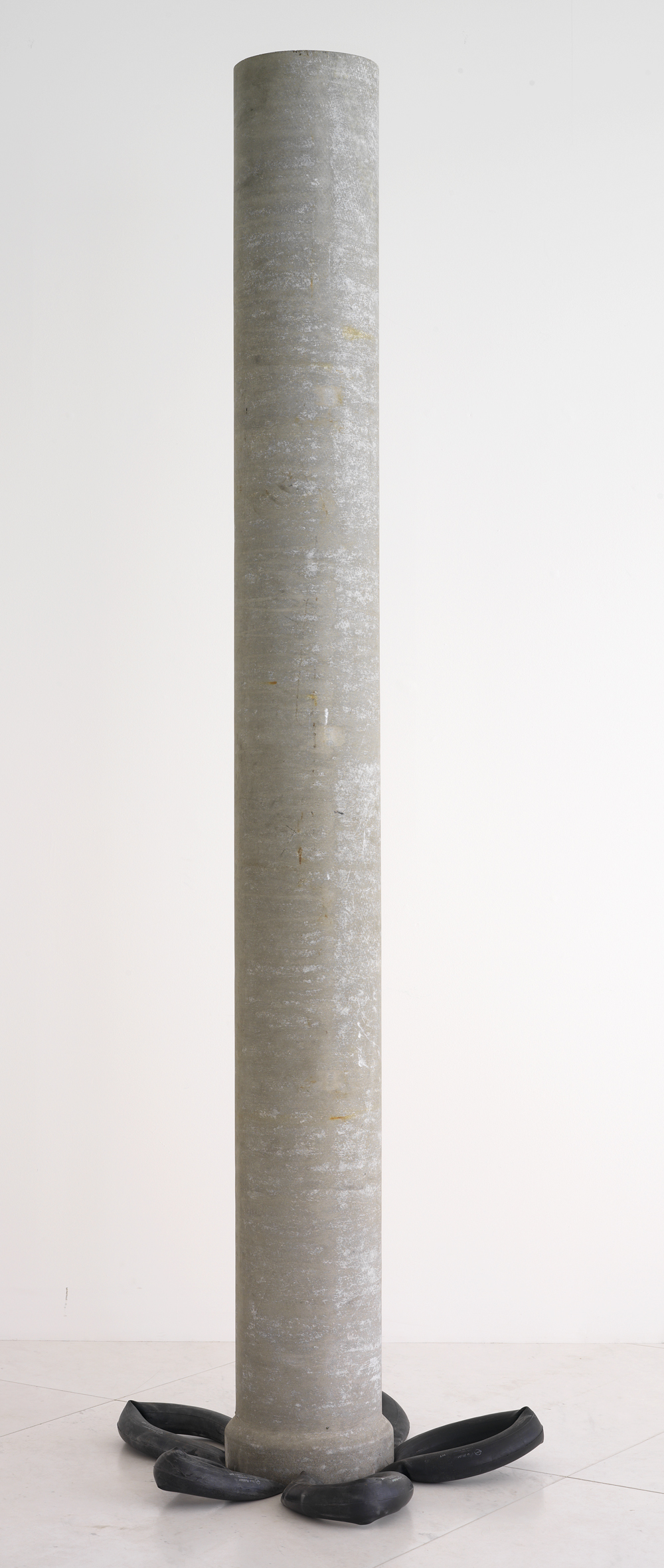
Colonna
Gilberto Zorio (Andorno Micca, Itália, 1944)
Fibre cement, rubber
285 x 30 x 30 cm
Coll. of the artist, long-term loan to Fundação de Serralves - Museu de Arte Contemporânea, Porto. Deposit 1999
'Colonna'[Column] is inspired by the building methods and materials that, as a child, Gilberto Zorio would find on the sites of his father’s construction company. The vertical cement column that comprises the work is supported by black rubber inner tubes, destabilizing the ideas of security and solidity that are usually associated with architecture. Through a critical and ironic citation of classical architecture, in which columns are indispensable, Zorio’s sculpture seems to celebrate precariousness. The work directly explores the tensions and flows of energies and forces that exist in the physical world, such as gravity, but it can also be seen, in its careful choice of materials and attention to composition, as an expression of the small alterations that transform everyday objects into art. Gilberto Zorio is an artist linked to the Italian arte povera movement that, in the mid-1960s, favoured process over end results in art making, and promoted the use of humble, unstable and perishable materials. Alcohol, gases such as helium and hydrogen, terracotta, and pieces of rubber are some of the materials used by Zorio to emphasize such processes as evaporation, crystallization, oxidation and elasticity. At the same time these materials stimulate all the senses to the perception of his works. His approach to natural transformations shows an implicit interest in the passage of a physical state to another within a certain timeframe.

Sonic Rotating Geometry Type D - Nickel Plated # 17
Haegue Yang (Seoul, Coreia do Sul, 1971)
Steel sheet, powder coating, ball bearings, metal grid, nickel plated bells, metal rings
100 x 100 cm
Coll. Fundação de Serralves - Museu de Arte Contemporânea, Porto, Portugal. Acquisition 2014
The four 'Sonic Rotating Geometries', part of a series begun in 2013, propose an overlay of formal and conceptual narratives. The interplay of geometry, colour, motion and sound is one of their essential components. Mounted directly onto a monochrome circular background painted on the wall, these geometric shapes are covered with nickel-plated bells that can be set in rotation by hand. The colours are selected from the palette of the decorative scheme designed in 1926-28 by Sophie Taeuber-Arp with Hans Arp and Theo Van Doesburg for the Salle des Fêtes and the Foyer Bar of the Aubette building in Strasbourg. With movement, these abstract forms are dissolved into a blurred geometry that recalls the optical illusions of Marcel Duchamp's 'Rotoreliefs' (1935). Yet in Yang's work, the visual effect is replaced by the oscillations of the bells, associated with Buddhist chimes or shamanist ceremonies. Bells are a recurring element in her recent work, in which sculpture becomes a presence that is pushed, pulled, worn or inhabited, creating resonating combinations of movement, light and sound.Haegue Yang’s sculptural propositions are part of a multivalent form of art making comprising a graphic as well as a sculptural oeuvre, and in which exhibition display itself constitutes a vital and choreographed dimension. Sound, movement, found objects and ready-made structures, such as clothing racks, venetian blinds and electric lamps and fans, have constituted the material for her physical environments and totem-like sculptures that suggest transience and evocations of mobility across time and space. In recent years, Yang has looked to the canon of modernist art, dance and costume design, from the Aubette designs, to Stravinksy’s The Rite of Spring of 1910 and The Triadic Ballet, designed by Bauhaus teacher Oskar Schlemmer in 1922.

4am Friday
Lynette Yiadom-Boakye (Londres, Reino Unido, 1977)
Oil on canvas
200 x 130 cm
Coll. Fundação de Serralves - Museu de Arte Contemporânea, Porto, Portugal. Acquisition 2016
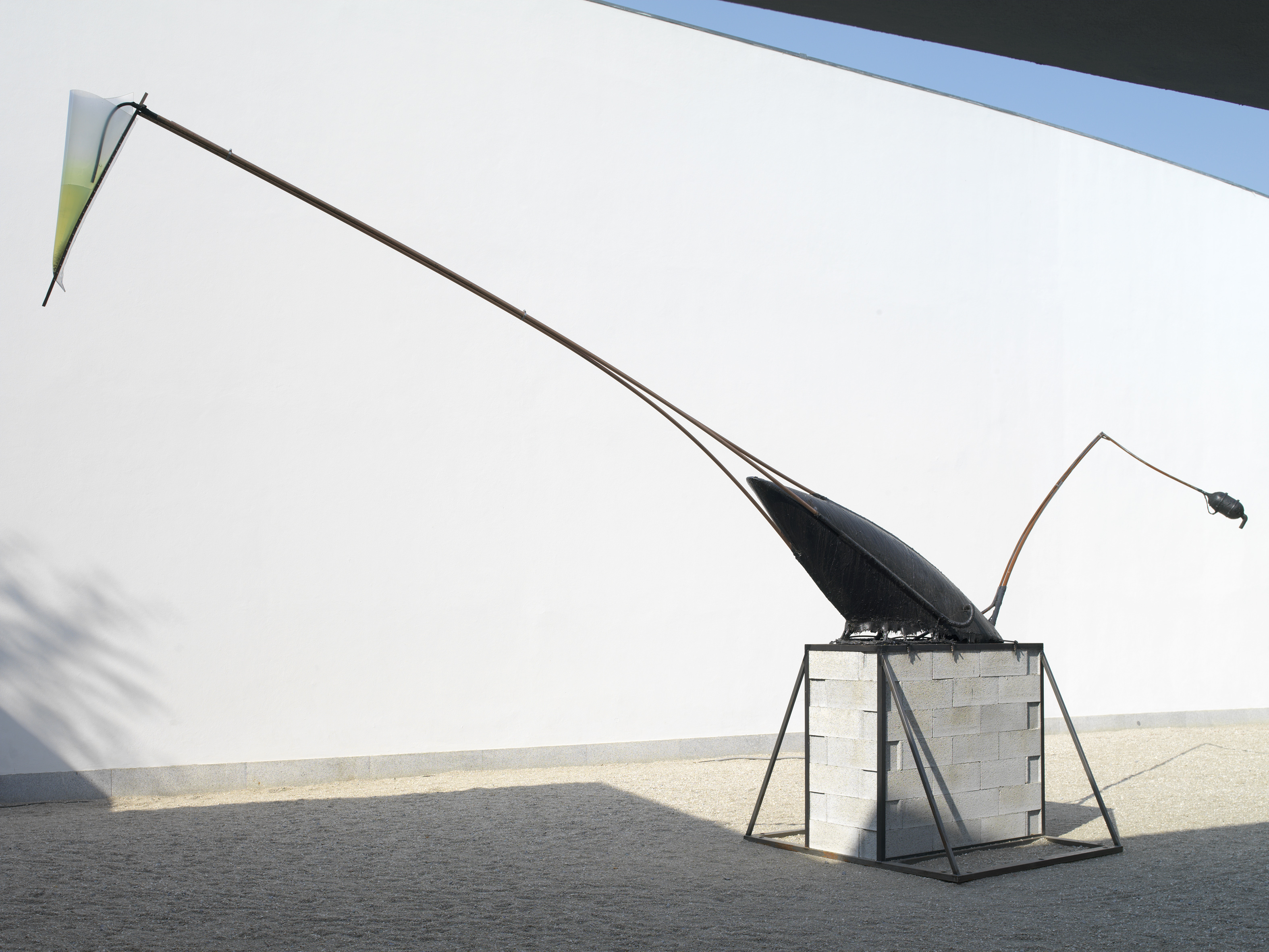
La canoa di Porto
Gilberto Zorio (Andorno Micca, Itália, 1944)
Wood covered in Polyester resin, iron tubes, copper tubes, PVC cone, fluorescent pigment, compressor, timer, sound
271 x 1090 x 210 cm
Coll. Fundação de Serralves - Museu de Arte Contemporânea, Porto, Portugal. Acquisition 1991
Gilberto Zorio created 'La canoa di Porto' [The Porto Canoe] for his exhibition at the Serralves Villa in 1990. Despite its large dimensions and rough character, the sculpture, built through a process of assemblage, is surprisingly light in appearance. It is for a large part made up of recycled units (canoe, tubes, PVC cone) kept in their original form rather than subjected to polishing, welding or any other form of disguise (except for the canoe itself, that was covered in polyester resin), the whole resembling a giant mobile projected in space. The sounds of a whistle and gurgling water seem to confer to it an animate nature. This performative character is common to Zorio’s sculptures, especially those created from 1990 onwards: they move, vibrate, oscillate, emit sounds.The canoe is a recurring element in Zorio’s work, for its elementary and ancestral character, the perfection of its form, worked on for centuries, and its strong symbolic charge as a means of projection through space and time. 'La canoa di Porto' does not breach and pierce the water as it cuts through the waves: crossing the elements of nature, from navigation in water, it ascends to navigation in the air. A key figure of arte povera, Gilberto Zorio shares with other artists in the movement the exploration of energy and the transformation of matter. His almost alchemical use of materials and the ingenious sound and visual effects it delivers are distinguishing features of his work.
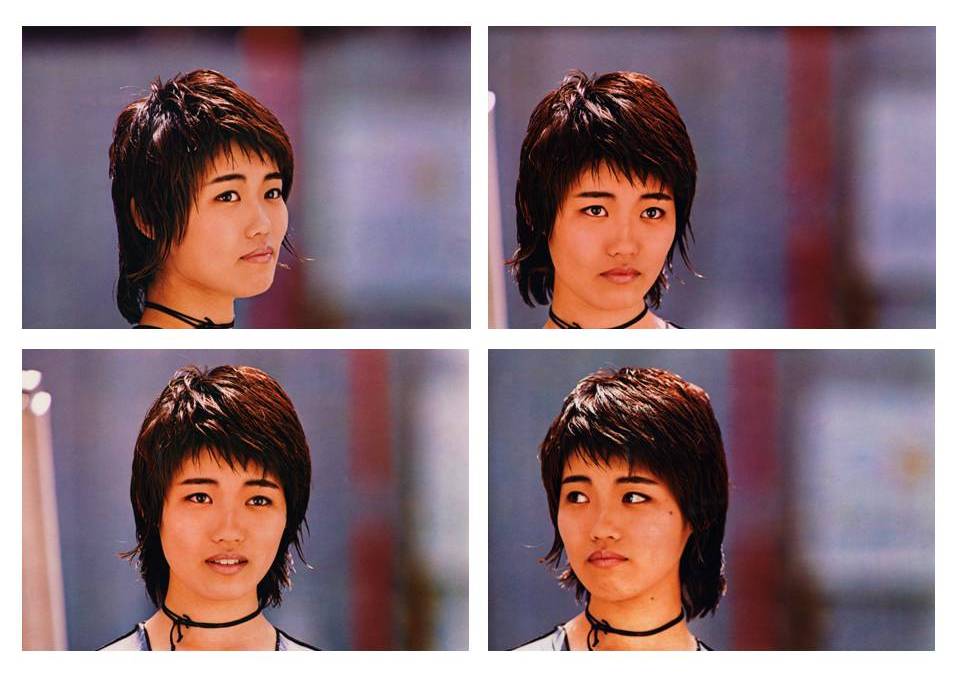
Atsue Sasaki (Nr 1, 2, 3, 4)
Christopher Williams (Los Angeles, EUA, 1956)
Dye transfer prints (4 elements)
27.9 x 35.6 cm (each)
Coll. Fundação de Serralves - Museu de Arte Contemporânea, Porto, Portugal. Acquisition 2005
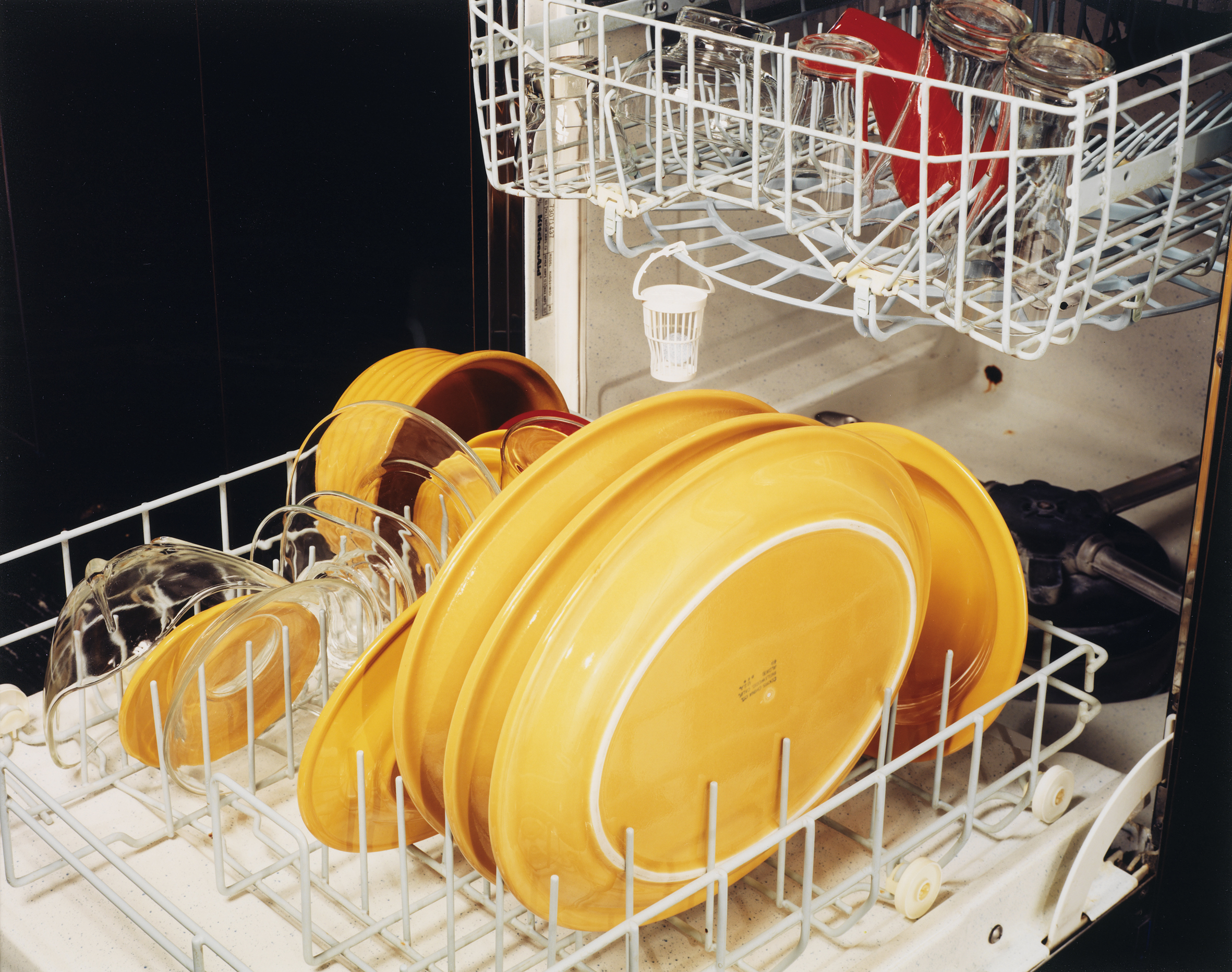
KODAK Color
Christopher Williams (Los Angeles, EUA, 1956)
C-print. A.P.
28 x 35.5 cm
Coll. Fundação de Serralves - Museu de Arte Contemporânea, Porto, Portugal. Acquisition 2005

Les 2 Bacs
Sarkis Zabunyan (Istambul, Turquia, 1938)
Plástico, água, bronze, néon, negativos de fotografias de maio de 1968
180 x 180 cm
Coll. Fundação de Serralves - Museu de Arte Contemporânea, Porto, Portugal. Acquisition 2017
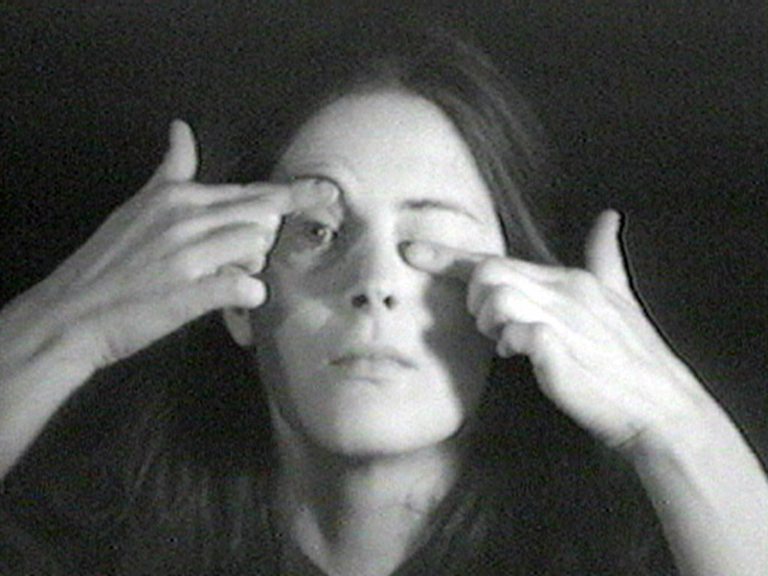
Gestures
Hannah Wilke (Nova Iorque, EUA, 1940 - Nova Iorque, EUA, 1998)
Video, b/w, sound, 4:3, PAL, 35'3'"
Coll. Fundação de Serralves - Museu de Arte Contemporânea, Porto, Portugal. Acquisition 1999
In ‘Gestures’, Hannah Wilke uses her skin as sculptural material in a series of actions in which she features simultaneously as artist and art object. Exploring her own face, and facing the viewer’s gaze directly, the artist creates a discourse in which she speaks of the objectifying representation of women and the relationship between pleasure and pain, echoing her double interest in the materiality of sculpture and feminist art.Hannah Wilke worked frequently on autobiographical, aesthetical, erotic, political or linguistic themes using a range of media, from sculpture to video and performance, and experimenting with materials that were unusual in the 1960s and 70s. Wilke’s oeuvre is marked by the use of her own body as instrument and object of visual expression, a way to affirm a specifically feminine iconography in a confrontation with both the patriarchal order prevalent in the history of art and popular culture and sexist attitudes within the feminist movement itself.
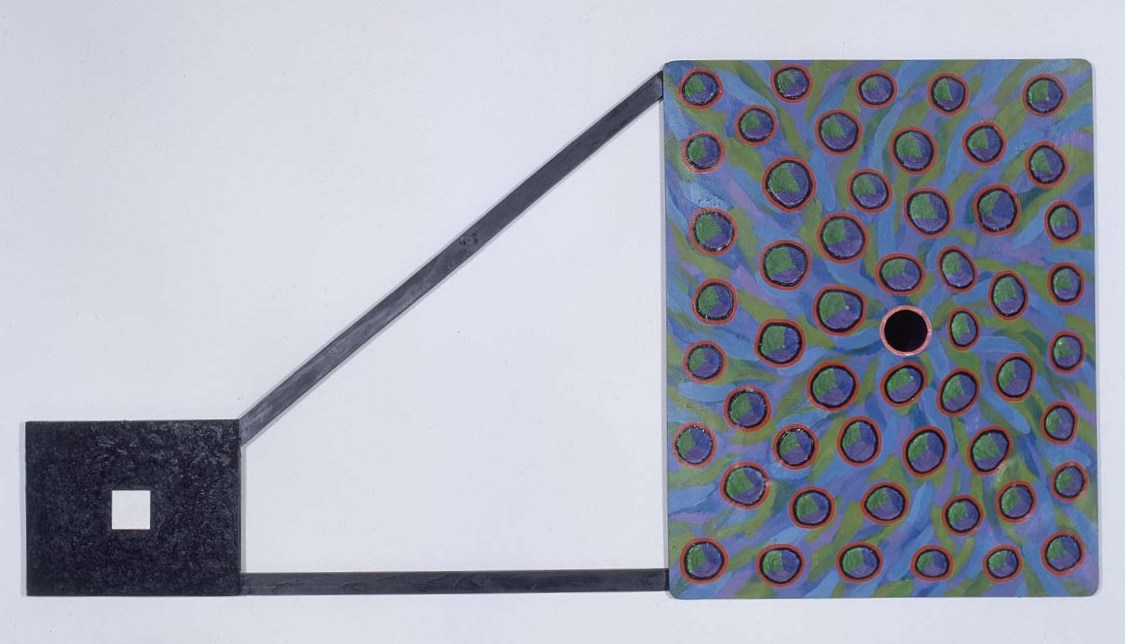
Sem título
Xana (Lisboa, Portugal, 1959)
Mixed media on canvas and wood
92 x 183.5 x 22 cm
Coll. Fundação Luso-Americana para o Desenvolvimento, long-term loan to Fundação de Serralves - Museu de Arte Contemporânea, Porto, Portugal. Deposit 2004
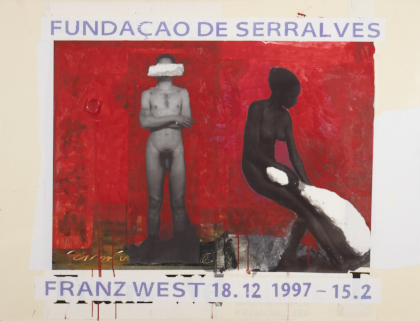
Am tiefen Nass
Franz West (Viena, Áustria, 1947 - Viena, Áustria, 2012)
Painting and collage on printed paper
97.2 x 125 cm
Coll. Fundação de Serralves - Museu de Arte Contemporânea, Porto, Portugal. Acquisition 1998

No Names
Yonamine (, Angola, 1975)
Técnica mista sobre tela
180 x 180 cm
Coll. Fundação de Serralves - Museu de Arte Contemporânea, Porto, Portugal. Acquisition 2017
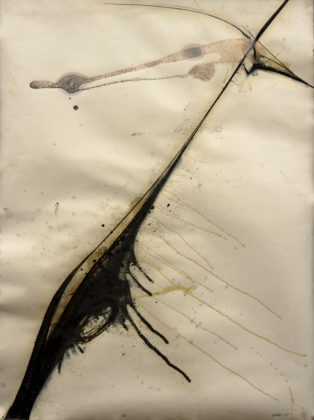
La canoa di Porto
Gilberto Zorio (Andorno Micca, Itália, 1944)
Mixed media on paper, aluminum and Plexiglass
120.5 x 92.5 x 6 cm
Private collection, long-term loan to Fundação de Serralves - Museu de Arte Contemporânea, Porto. Deposit 2002
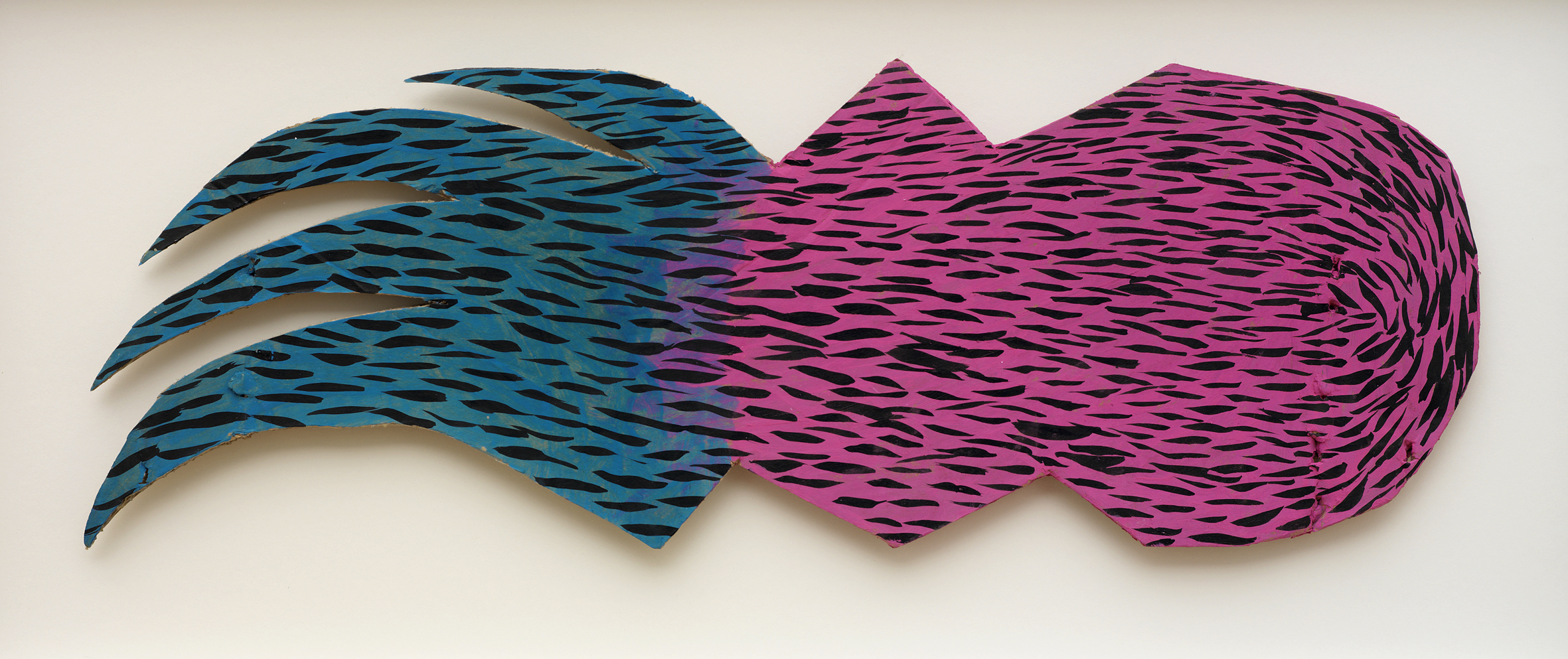
Sem título
Xana (Lisboa, Portugal, 1959)
Acrylic paint on cardboard
17 x 50 cm
Coll. Fundação de Serralves - Museu de Arte Contemporânea, Porto, Portugal. Donation by Fernando Figueiredo dos Santos 2000
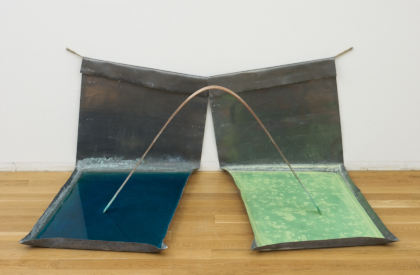
Piombi
Gilberto Zorio (Andorno Micca, Itália, 1944)
Lead plate, copper sulphate, chloric acid, rope
95 x 250 x 160 cm
Coll. Fundação de Serralves - Museu de Arte Contemporânea, Porto, Portugal. Acquisition 1998
Partly lying on the floor, partly propped against the wall, two lead plates have been converted into shallow basins. The two plates remain in contact on top and fold one over the other. The lower part of each plate serves as a recipient into which chemical solutions have been poured: copper sulphate (blue solution) into one, chloric acid (green solution) into the other. The tips of a copper rod bent into an arch dips into each of them. The installation works as a galvanic battery and the chemical reactions gradually transfigure the sculpture: at one end the copper sulphate forms blue crystals; at the other the chloric acid generates green crystals. Lead also reacts, forming white crystals. In 'Piombi' [Leads] Zorio reveals his profound interest in transformation and the energy potential of elements. In making the work, Zorio was not moved by scientific purpose, but rather interested in bringing out the poetic dimension of material an physical processes, namely the chromatic alterations that result, in his own words, in ‘dream colours’, as well as in the invincible power, or even the threatening violence, of natural phenomena. Zorio’s predilection for lead is not an accident. Lead was also the alchemists’ material of choice. The ancestral dimension of lead, one of the first metals to have been worked by man, is highly relevant to the artist. Zorio’s first solo exhibition in Turin in 1967 led Germano Celant to associate him with arte povera. Movement, energy and transformation through a chain of processes cross the whole of Zorio’s oeuvre, which is also characterized by an enormous diversity of materials. The combination and interaction of the various elements unleash chemical reactions, processes of mutation and releases energy with visual results.
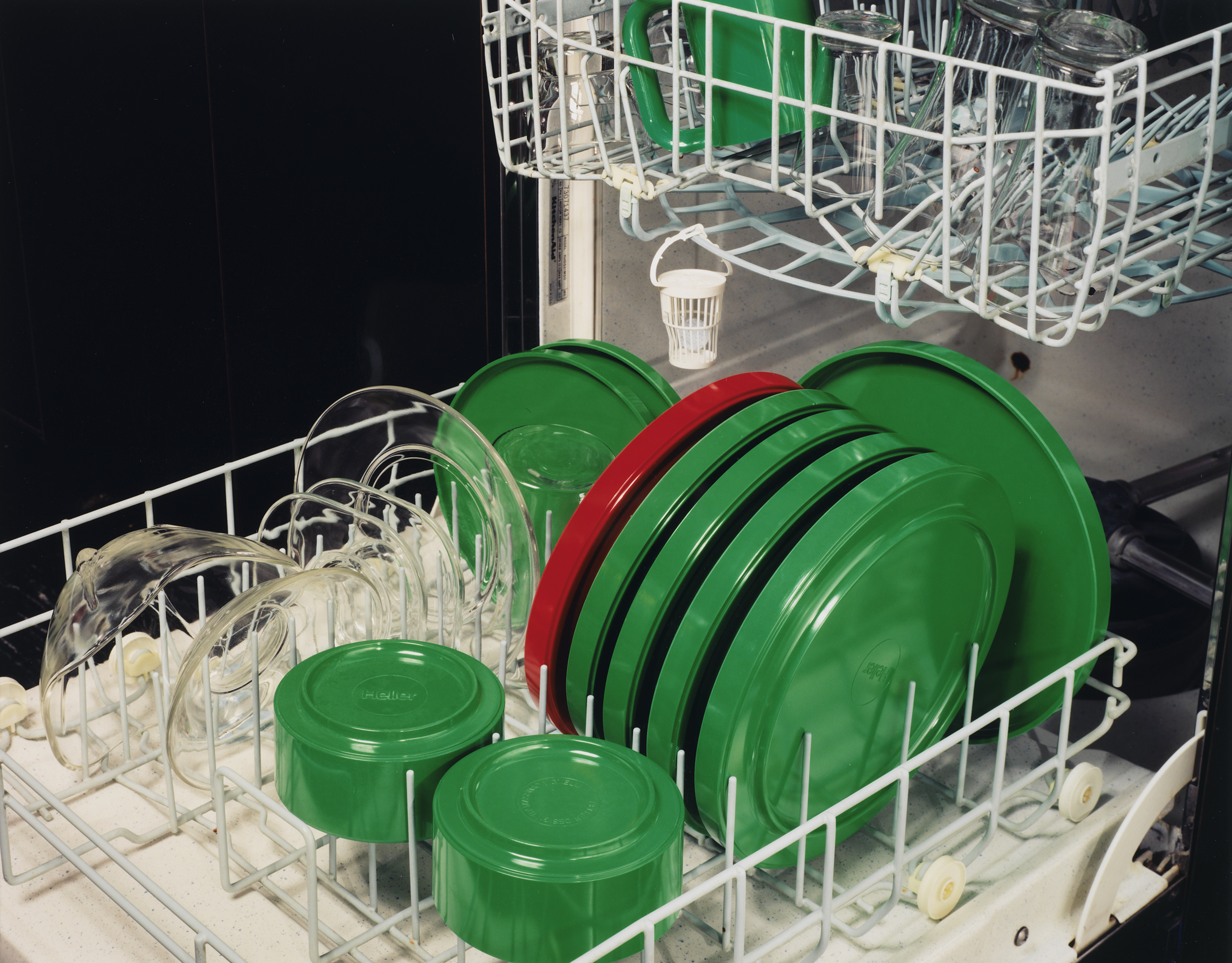
FUJI Color
Christopher Williams (Los Angeles, EUA, 1956)
C-print. A.P.
28 x 35.5 cm
Coll. Fundação de Serralves - Museu de Arte Contemporânea, Porto, Portugal. Acquisition 2005

Sem título
Christopher Wool (Chicago, EUA, 1955)
Silkscreen ink on paper
182.9 x 140.3 cm
Coll. Fundação de Serralves - Museu de Arte Contemporânea, Porto, Portugal. Artist's donation 2008
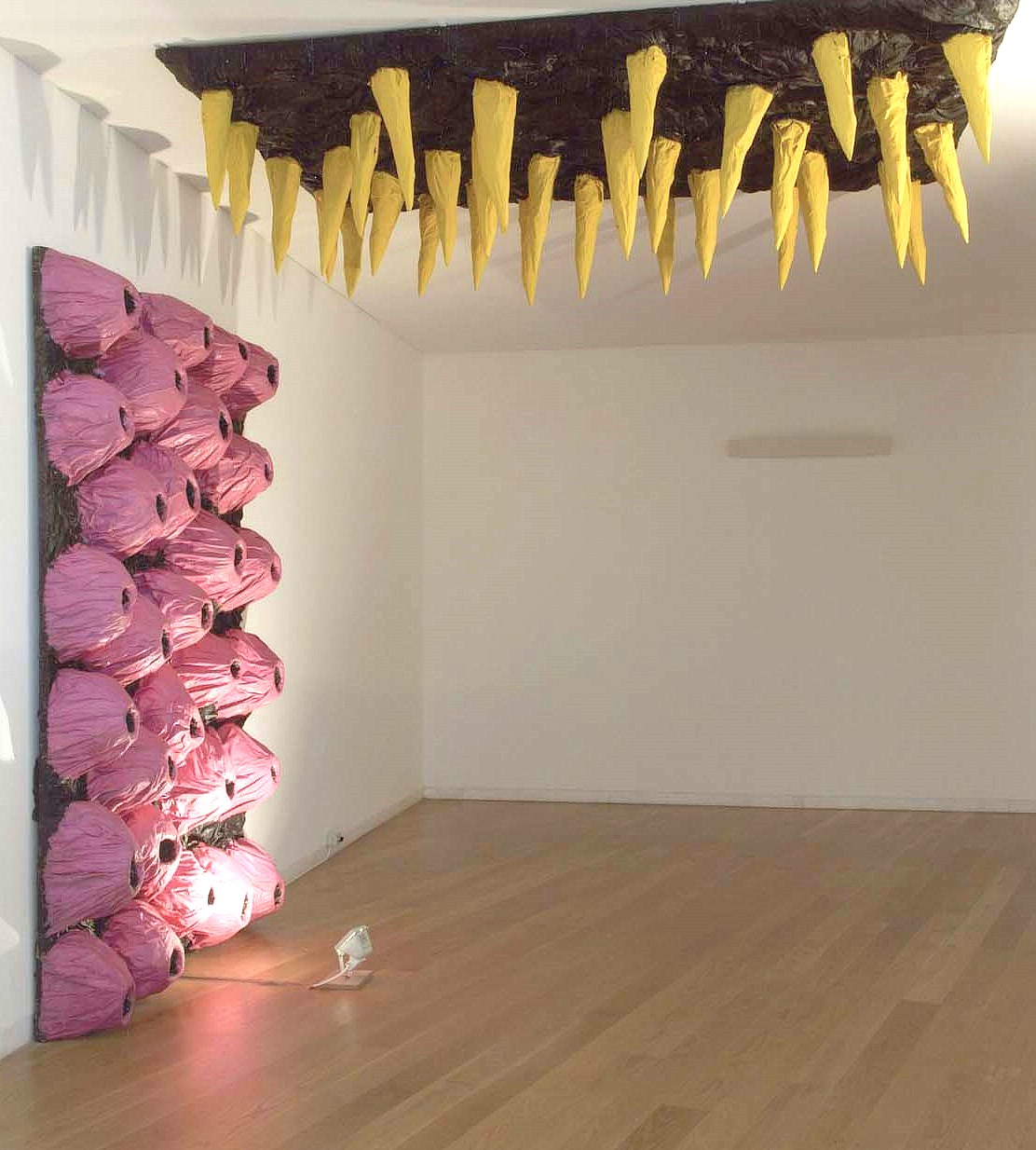
Enigma Negro
Xana (Lisboa, Portugal, 1959)
Wood, acrylic paint on canvas and paper (2 elements)
30 x 180 x 280 cm (each)
Coll. Fundação de Serralves - Museu de Arte Contemporânea, Porto, Portugal. Acquisition 2005

Amália Traída
Francesco Vezzoli (Brescia, Itália, 1971)
Video, b/w, colour, sound, 9'40"
Coll. Fundação de Serralves - Museu de Arte Contemporânea, Porto, Portugal. Artist's donation 2005
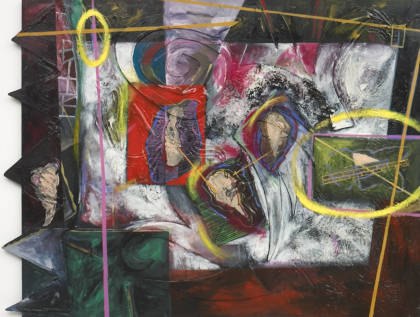
Mural
Ana Vidigal (Lisboa, Portugal, 1960)
Collage, acrylic paint and wood on canvas
120 x 157.5 cm
Coll. Portuguese State Secretariat of Culture, long-term loan to Fundação de Serralves - Museu de Arte Contemporânea, Porto. Deposit 1990
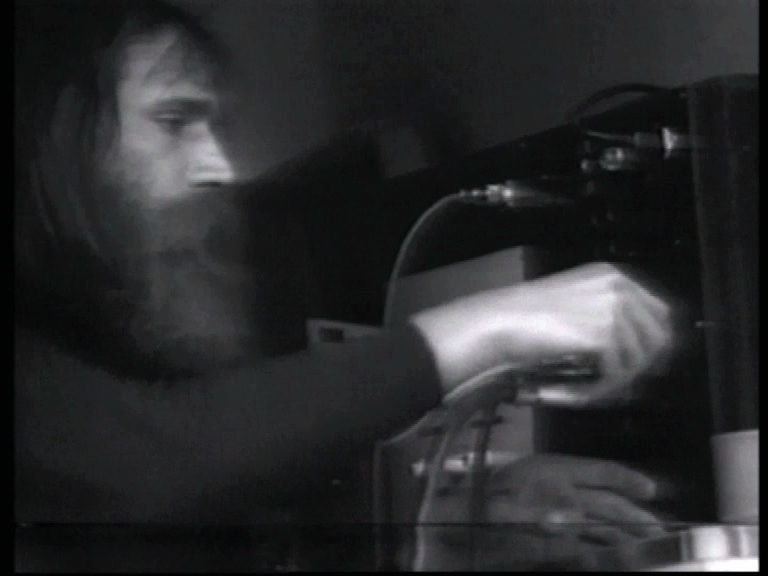
Videoworks of Lawrence Weiner, vol.1:
Lawrence Weiner (Bronx, EUA, 1942)
Video (Betacam), b/w and colour, sound, PAL, 46’
Coll. Fundação de Serralves - Museu de Arte Contemporânea, Porto, Portugal. Acquisition 1999
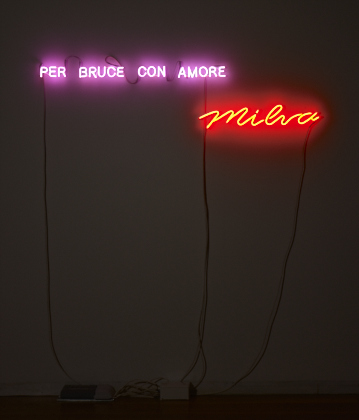
Greatest Hits - Milva canta Bruce Nauman: "Vattene dalla mia mente! Vattene da questa stanza! (Get out of my mind! Get out of this room!)"
Francesco Vezzoli (Brescia, Itália, 1971)
Sound and neon
Variable dimensions
Coll. Fundação de Serralves - Museu de Arte Contemporânea, Porto, Portugal. Artist's donation 2005

Mesa-Paisagem (Lua)
Ana Vieira (Coimbra, Portugal, 1940 - Lisboa, Portugal, 2016)
Silkscreen on paper. Ed. 6/200
56 x 76 cm
Coll. Portuguese State Secretariat of Culture, long-term loan to Fundação de Serralves - Museu de Arte Contemporânea, Porto. Deposit 1990

Mesa-Paisagem (Barco)
Ana Vieira (Coimbra, Portugal, 1940 - Lisboa, Portugal, 2016)
Silkscreen on paper. A.P. II/XX
47 x 66.6 cm
Coll. Portuguese State Secretariat of Culture, long-term loan to Fundação de Serralves - Museu de Arte Contemporânea, Porto. Deposit 1990
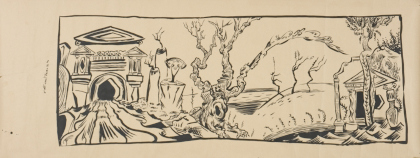
Sem título
Manuel João Vieira (Lisboa, Portugal, 1962)
Indian ink on paper
100 x 262.5 cm
Coll. of the artist, long-term loan to Fundação de Serralves - Museu de Arte Contemporânea, Porto. Deposit 2004
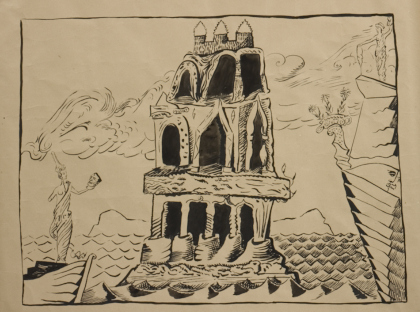
Sem título
Manuel João Vieira (Lisboa, Portugal, 1962)
Indian ink on paper
100 x 130 cm As dimensões são irregulares
Coll. of the artist, long-term loan to Fundação de Serralves - Museu de Arte Contemporânea, Porto. Deposit 2004

Mokba (Moscovo)
Pires Vieira (Porto, Portugal, 1950)
Óleo sobre tela, óleo sobre chapa acrílica (20 elementos)
Dimension variable
Coll. Fundação de Serralves - Museu de Arte Contemporânea, Porto, Portugal. Artist's donation 2018

Continuum 9/69 (Continuum I)
Pires Vieira (Porto, Portugal, 1950)
Pigmento aquoso sobre tela de algodão
80.7 x 116.2 cm
Coll. Fundação de Serralves - Museu de Arte Contemporânea, Porto, Portugal. Acquisition 2018

Sem título
Manuel João Vieira (Lisboa, Portugal, 1962)
Indian ink on paper
100 x 273 cm
Coll. of the artist, long-term loan to Fundação de Serralves - Museu de Arte Contemporânea, Porto. Deposit 2004

Pintura da série 'Mattisse, Rothko, Ad Reinhardt'
Pires Vieira (Porto, Portugal, 1950)
Pigmento aquoso sobre tela de algodão
196 x 186 cm
Coll. Fundação de Serralves - Museu de Arte Contemporânea, Porto, Portugal. Acquisition 2018

Mesa-Paisagem (Barco)
Ana Vieira (Coimbra, Portugal, 1940 - Lisboa, Portugal, 2016)
Silkscreen on paper. A.P. V/XX
47 x 67 cm
Coll. Portuguese State Secretariat of Culture, long-term loan to Fundação de Serralves - Museu de Arte Contemporânea, Porto. Deposit 1990

Sem título
Ana Vieira (Coimbra, Portugal, 1940 - Lisboa, Portugal, 2016)
Silkscreen on paper. A.P. V/XX
47 x 67 cm
Coll. Museu Nacional de Soares dos Reis, long-term loan to Fundação de Serralves - Museu de Arte Contemporânea de Serralves, Porto. Deposit 1990
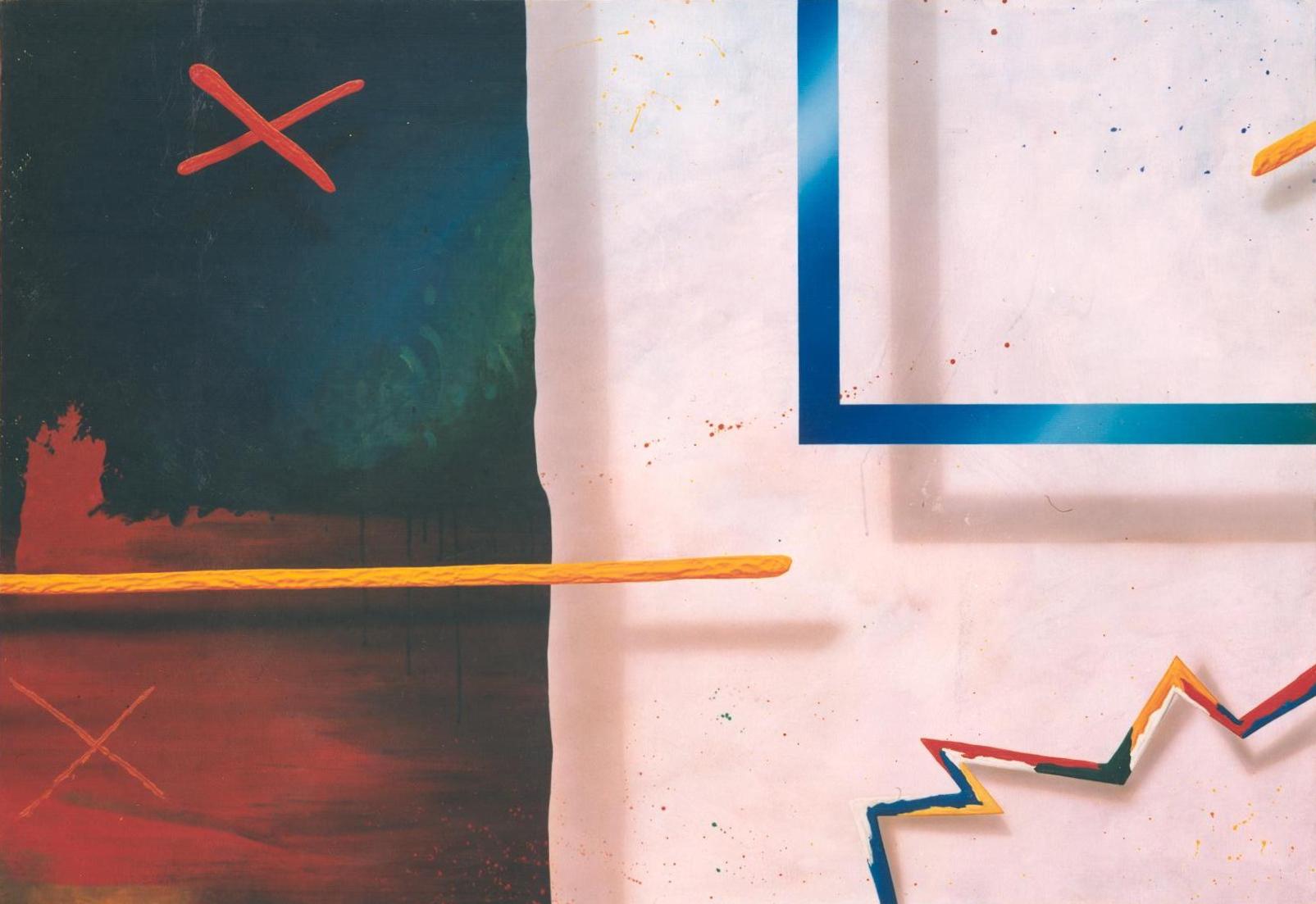
Azul e negro, distanciação
Gabriela Vaz (, , 1962)
Mixed media on canvas
90 x 130 cm
Private collection, long-term loan to Fundação de Serralves - Museu de Arte Contemporânea, Porto. Deposit 1992

Espaço cénico
Gabriela Vaz (, , 1962)
Mixed media on canvas
222.5 x 188.2 cm
Private collection, long-term loan to Fundação de Serralves - Museu de Arte Contemporânea, Porto. Deposit 1992

Vier Felder (four fields - four people), single element nº21 of 1.Werksatz
Franz Erhard Walther (Fulda, Alemanha, 1939)
Dyed canvas. Ed. 3/5
Dimension variable
Coll. Fundação de Serralves - Museu de Arte Contemporânea, Porto, Portugal. Acquisition 2015
Franz Erhard Walther’s sculptural and performative work challenged the spatial, sensory and temporal concepts associated with the exploration of forms during the 1960s, enabling him to explore the relationship between artwork and spectator on the basis of specific conditions of interaction. ‘Vier Felder (Four Fields - Four People), Single Item no. 21 of 1. Werksatz’ is one of a series of works that can function as an object, or may be activated and manipulated performatively by a set of participants, following the relational and participatory conditions set in the instructions predefined by the artist.Franz Erhard Walther explored the relationship between object and action, in a work that spanned various media. His oeuvre is distinguished in particular by his participatory works - that intersect sculpture and performance - in which the spectators’ bodies become means to activate, reveal or invent the formal possibilities of the sculptural objects, thus enabling the spectators to gain a corporeal experience of the genesis of the sculpture’s form.
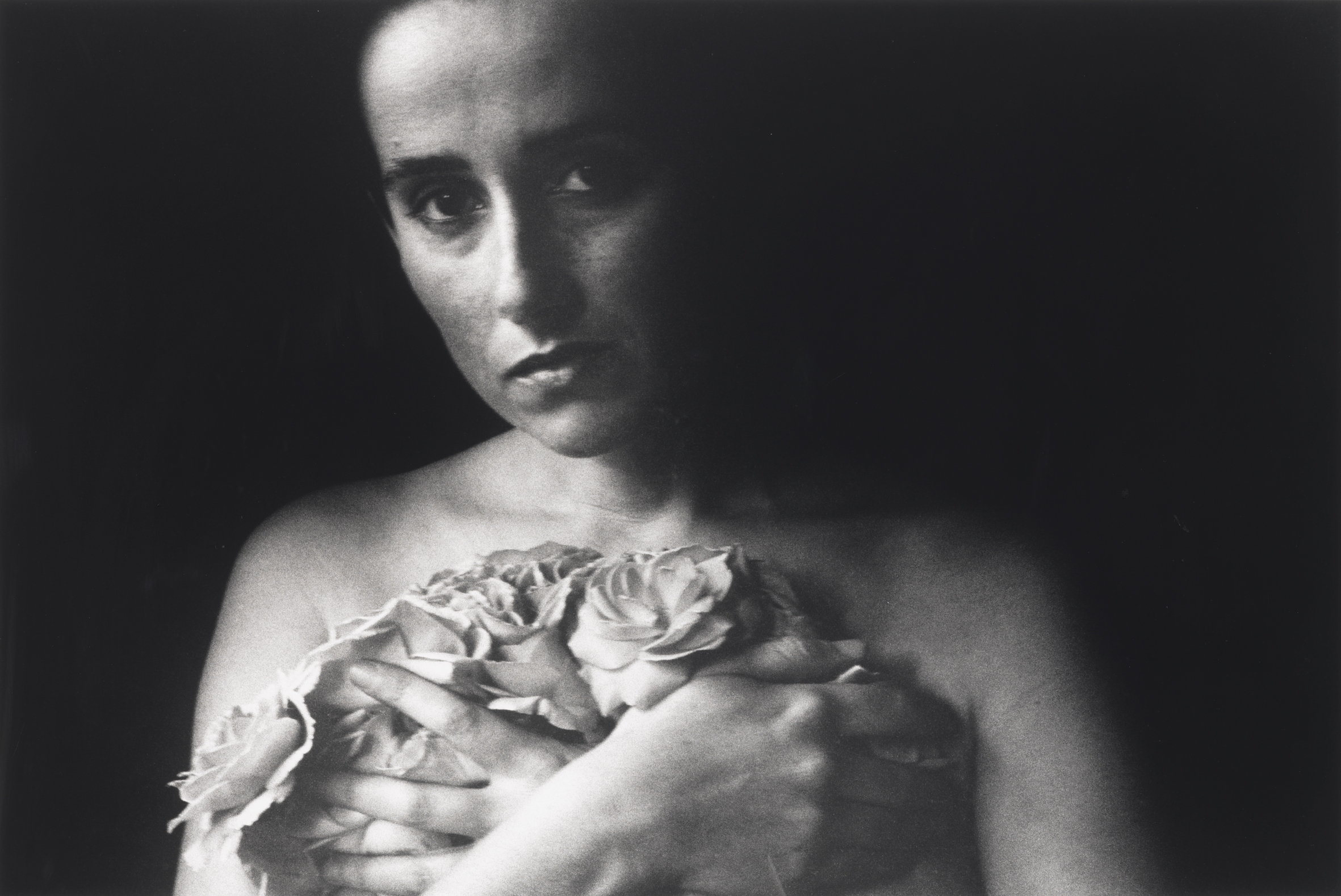
Sem título
Júlia Ventura (Lisboa, Portugal, 1952)
B/w photograph
92 x 119 cm
Coll. Fundação de Serralves - Museu de Arte Contemporânea, Porto, Portugal. Acquisition 2005
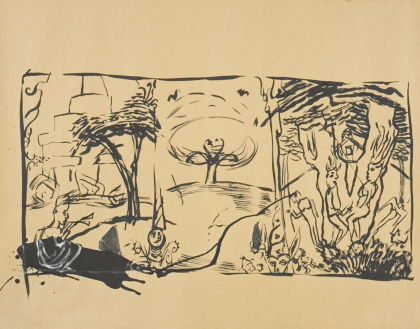
Sem título
Manuel João Vieira (Lisboa, Portugal, 1962)
Indian ink on paper
100 x 127.5 cm
Coll. of the artist, long-term loan to Fundação de Serralves - Museu de Arte Contemporânea, Porto. Deposit 2004
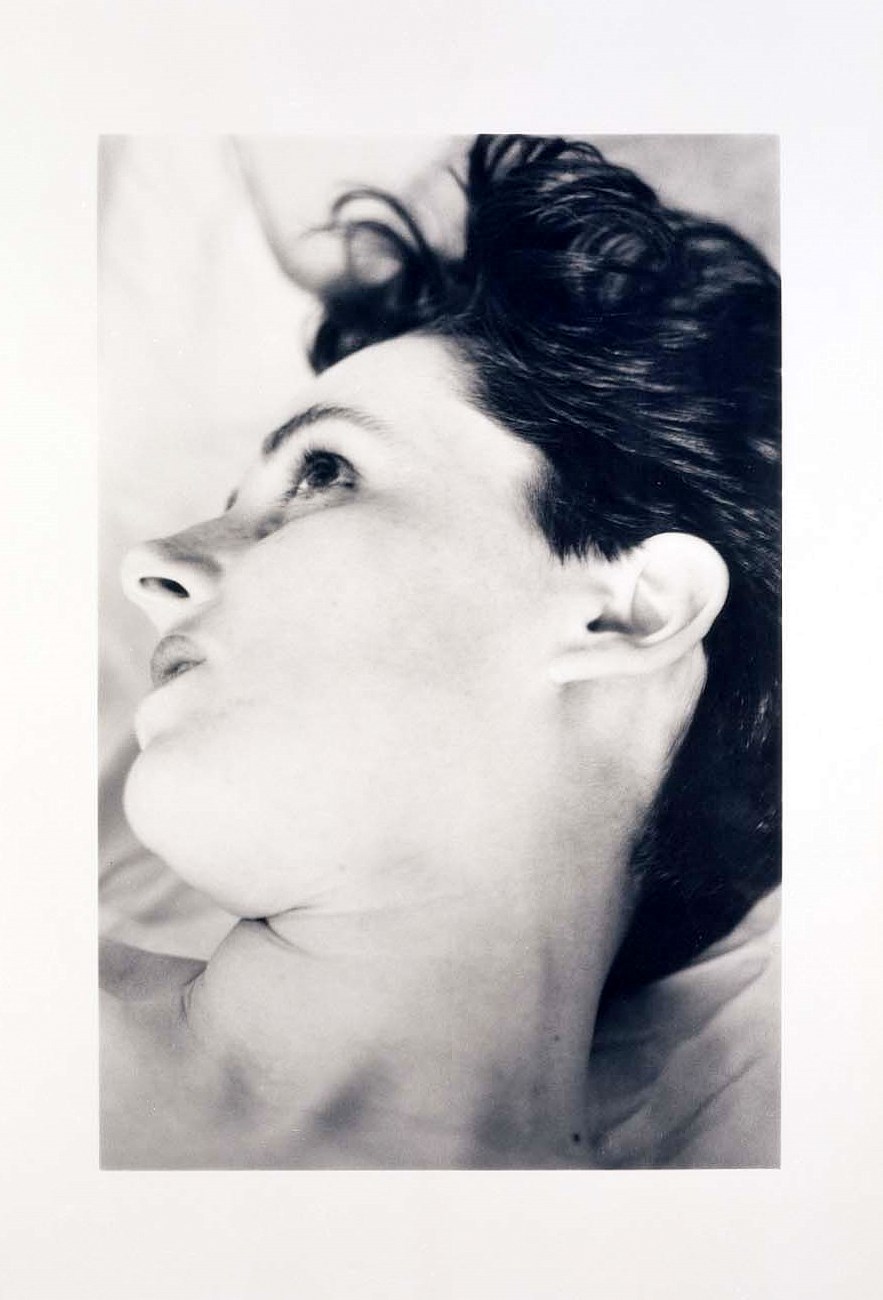
Sem título
Júlia Ventura (Lisboa, Portugal, 1952)
B/w photograph
175 x 123 cm
Coll. Fundação de Serralves - Museu de Arte Contemporânea, Porto, Portugal. Acquisition 1993

A agressão II
Joaquim Pinto Vieira (Avintes, Portugal, 1946)
B/w photograph, colour pencil (4 elements)
99 x 68.8 cm (each)
Coll. Joaquim Pinto Vieira, long-term loan to Fundação de Serralves - Museu de Arte Contemporânea, Porto, Portugal. Deposit 2001

Erdbeeren
Wolf Vostell (Leverkusen, Alemanha, 1932 - Berlim, Alemanha, 1998)
Cut-out lead plate stitched to b/w photograph framed in painted plywood mounted in a lead box
56.5 x 79.8 x 12.5 cm
Coll. Portuguese State Secretariat of Culture, long-term loan to Fundação de Serralves - Museu de Arte Contemporânea, Porto. Deposit 1990
'Erdbeeren' [Strawberries] originated in one of the series of street actions that Wolf Vostell started in 1958 aiming at tearing down the barriers between art and life. The happening consisted of a bus circulating on the streets of Berlin for three days; the vehicle was completely clad in lead and communication with the outside was only possible by television monitors mounted on the sides of the bus showing a live transmission of what happened inside it: a strawberry plantation trying to survive in an environment deprived of natural light or air. In the street, Vostell interviewed Berliners about what pleased them most in the city. 'Erdbeeren' is a metaphor for Berlin life in those years: conditioned, isolated and divided by a wall that constituted the most visible manifestation of the political-ideological iron curtain that separated the West and the East from the end of the war until 1989.
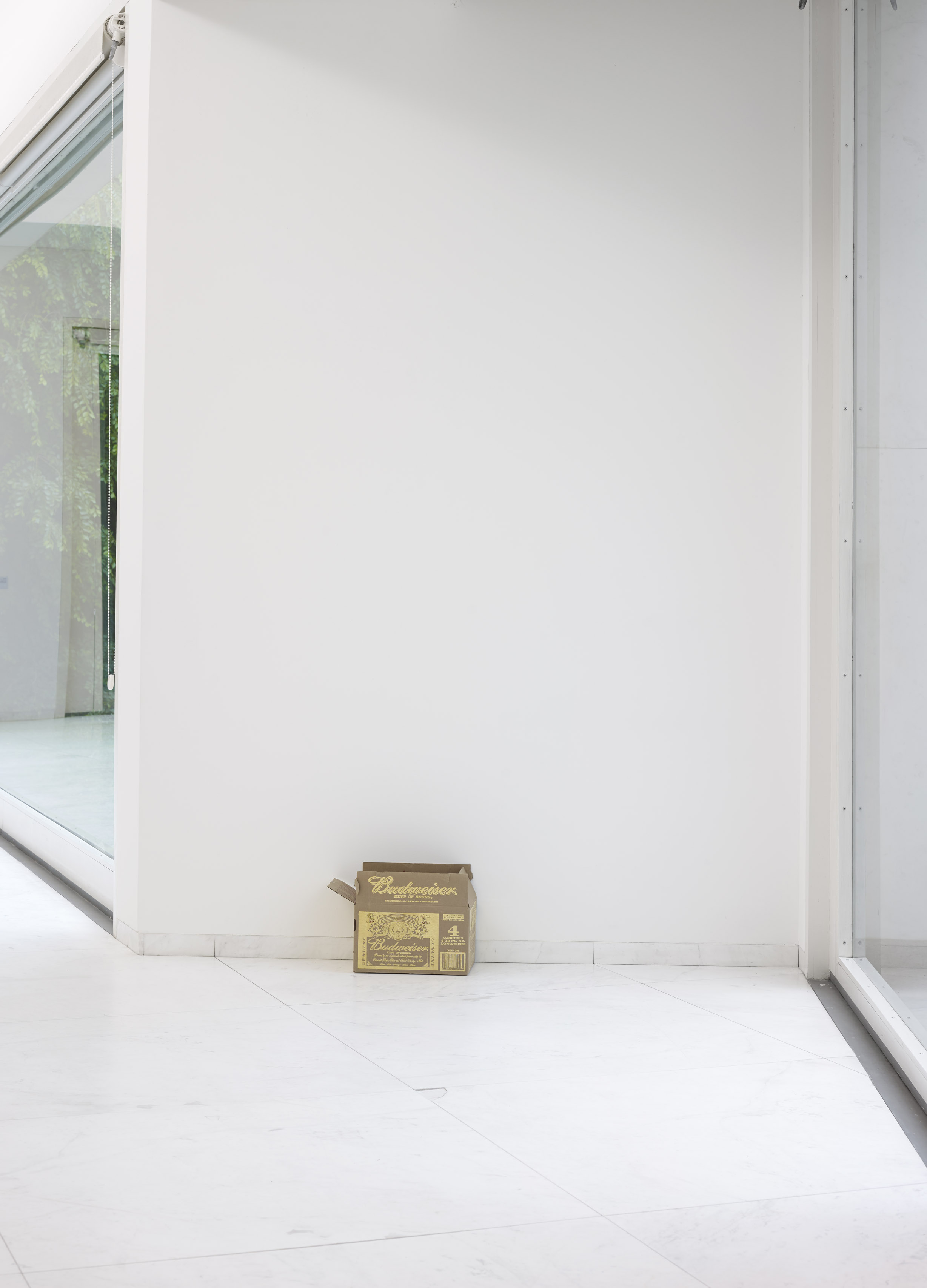
Fabulous Muscles
Danh Võ (Bà Ria, Vietname, 1975)
Cardboard, gold leaf, ink. Writing by Phung Vo
35 x 33.5 x 52 cm
Coll. Fundação de Serralves - Museu de Arte Contemporânea, Porto, Portugal. Acquisition 2013
'Fabulous Muscles' draws on contemporary forms of commodity production and circulation. On what appears to be a simple cardboard box of worldwide-distributed Budweiser beer, the artist had the name of the brand printed in gold leaf by a Thai workshop. The calligraphic text ? an excerpt of the lyrics of a song featured on the album Fabulous Muscles by North American group Xiu Xiu ? was written by Danh Võ’s father, Phung Võ. Formally recalling Andy Warhol’s famous Brillo Boxes, the work addresses the displacement and precariousness that defines labour conditions in our time through strictly personal references. Frequently comprised of documents, photographs, found objects or appropriated works by other artists, Võ’s oeuvre sets out a radical inquiry on the protocols of legitimation, authorship and authenticity, and the circulation of ideas and ideologies in a compelling fusion of personal experience and collective history.
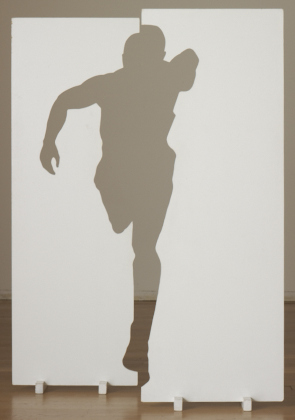
Sem título
Ana Vieira (Coimbra, Portugal, 1940 - Lisboa, Portugal, 2016)
Enamel on wood (2 elements)
173 x 112.5 x 18 cm
Coll. Fundação de Serralves - Museu de Arte Contemporânea, Porto, Portugal. Acquisition 1998

Sem título
Manuel João Vieira (Lisboa, Portugal, 1962)
Indian ink on paper
100 x 447 cm
Coll. of the artist, long-term loan to Fundação de Serralves - Museu de Arte Contemporânea, Porto. Deposit 2004
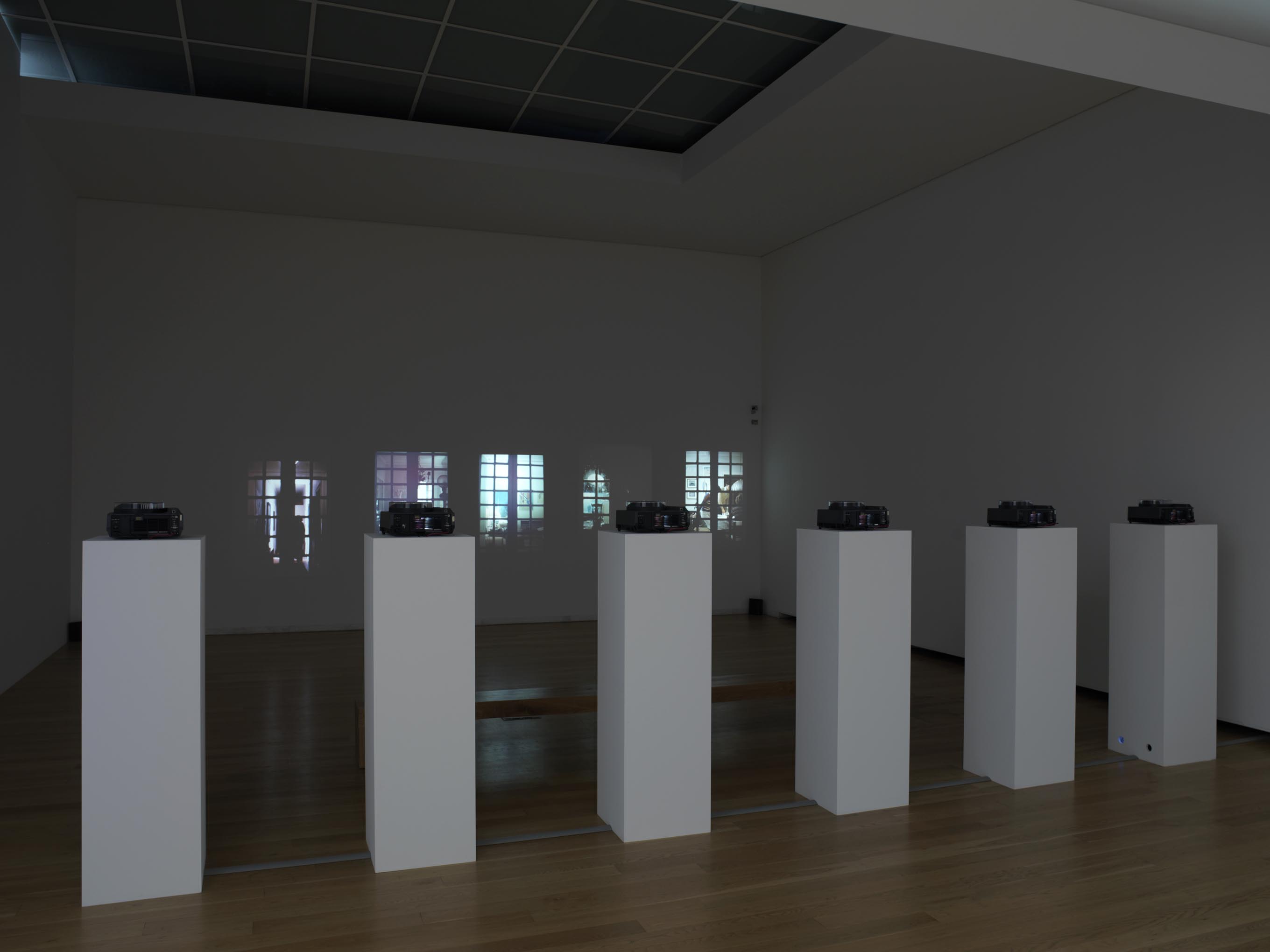
Janelas
Ana Vieira (Coimbra, Portugal, 1940 - Lisboa, Portugal, 2016)
Slide projection, sound
Dimensions variable
Coll. Fundação de Serralves - Museu de Arte Contemporânea, Porto, Portugal. Artist's donation 2002
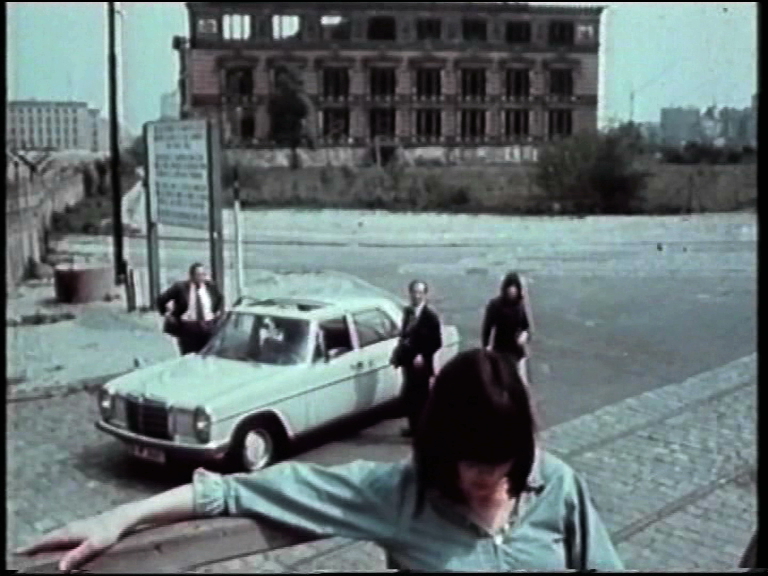
A Second Quarter
Lawrence Weiner (Bronx, EUA, 1942)
Video (Betacam), colour, sound, 88’, PAL
Coll. Fundação de Serralves - Museu de Arte Contemporânea, Porto, Portugal. Acquisition 1999

Quarto de Fernando Pessoa
João Vieira (Vidago, Portugal, 1934 - Lisboa, Portugal, 2009)
Acrylic, metal, electrical installation, 3 printers, 1 computer, microphones, presence sensor, continuous paper
Dimensions variable
Coll. of the artist, long-term loan to Fundação de Serralves - Museu de Arte Contemporânea, Porto. Deposit 2001
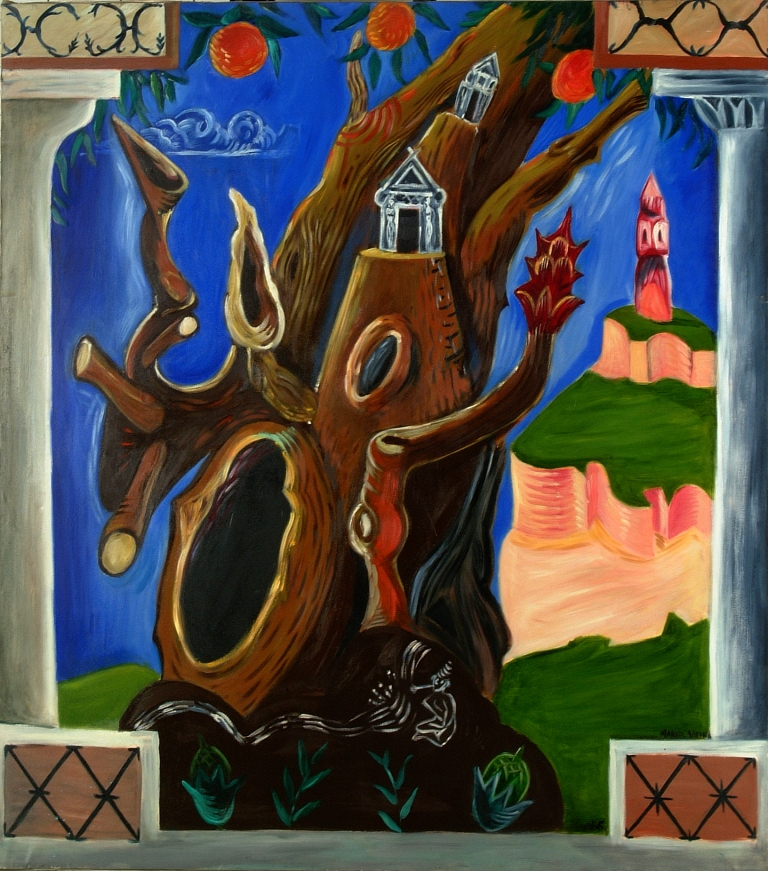
Homem com cachimbo
Manuel João Vieira (Lisboa, Portugal, 1962)
Oil on canvas
180 x 160 cm
Coll. Fundação Luso-Americana para o Desenvolvimento, long-term loan to Fundação de Serralves - Museu de Arte Contemporânea, Porto, Portugal. Deposit 2004
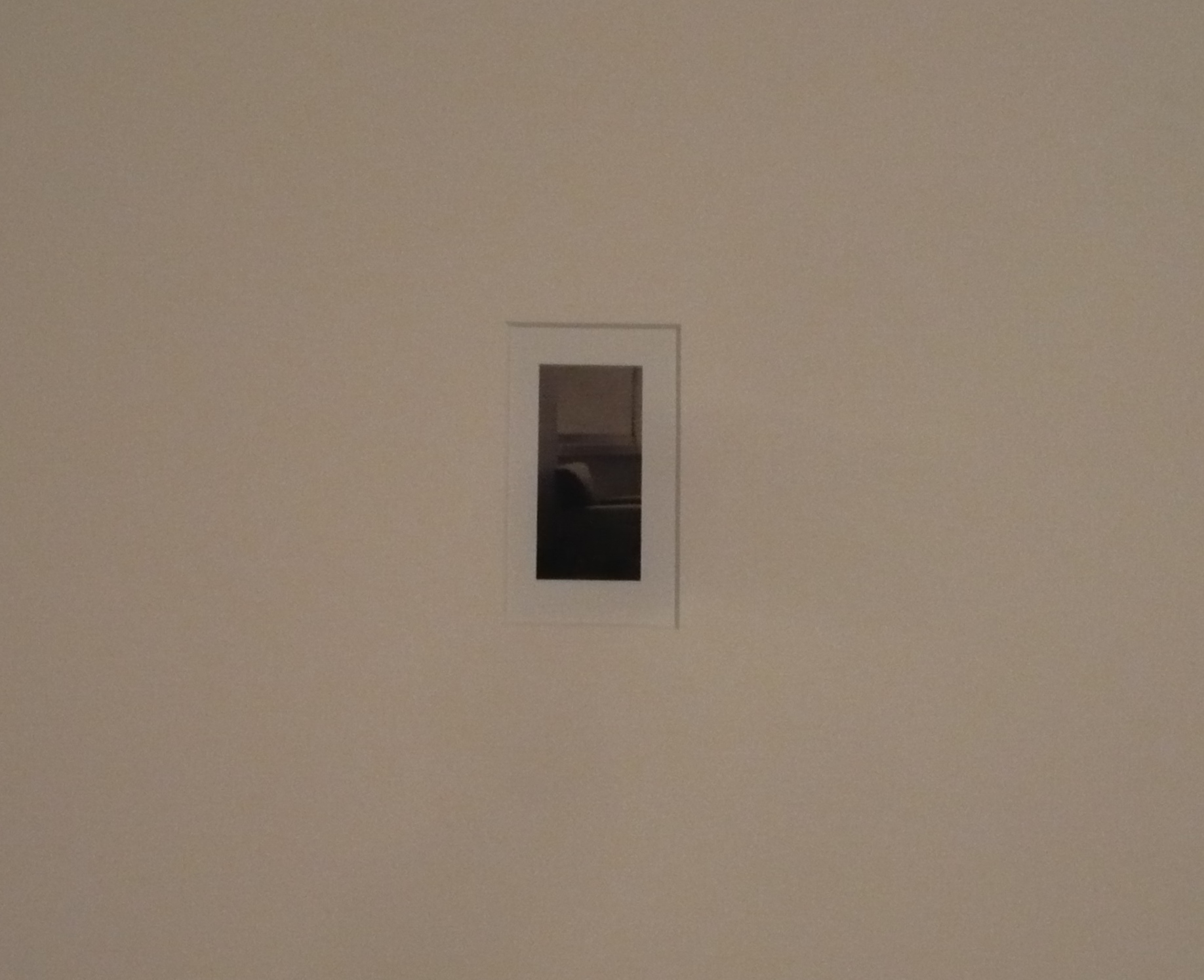
Sem título
Pedro Sousa Vieira (Porto, Portugal, 1963)
Laser sublimation print on paper
20.2 x 15.1 cm
Coll. Ivo Martins, long-term loan to Fundação de Serralves - Museu de Arte Contemporânea, Porto, Portugal. Deposit 2013
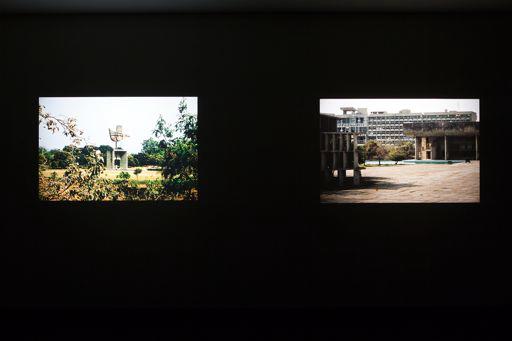
A Watermark: Capitol Complex
Tris Vonna-Michell (Essex, Reino Unido, 1982)
Dupla instalação de diapositivos, 35mm, sincronizada com composição musical e excerto falado
Dimensions variable
Coll. Fundação de Serralves - Museu de Arte Contemporânea, Porto, Portugal. Acquisition 2016
Layering photographic images, film and soundtracks, Tris Vonna-Michell (Essex, UK, 1982) threads together disparate historical information and social observation, filtered through personal anecdotes. The entangled narratives of these works slide between fact and fiction, drawing us into complex situations that a narrator is also grappling with. The dense assemblages of visual material are animated by intense monologues propelled by the artist’s distinctive voice. Informed by experimental writers such as Allen Ginsberg, Vonna-Michell’s spoken word compositions are full of detours, repetitions and dead ends that unravel into circuitous streams of association. Vonna-Michell’s ongoing storylines are often interconnected and retold, and continually reference his own artistic production. Images drawn from his personal archive, including those of previous works, reappear in new configurations. Acutely aware of the impact of gallery contexts on every installation, he repositions his accumulated performance documents, photographs and audio recordings for each new iteration. The analogue technology in these works acts as a further reminder of temporal instability.'A Watermark: Capitol Complex', an installation consisting of a double slide projection synchronized with a musical composition and a spoken track, is based on the story of two projects by renowned architect Le Corbusier built in recently independent India: the city of Chandigarth and its Capitol Complex. In their monumentality, they should have exemplarily represented the dream of a modern India and the values of democracy, but ended up symbolizing bureaucracy and the failure of modernist utopias. The voice-over soundtrack features the main character Traveller, whose calm nocturnal strolls through the city become increasingly anxious and confused as he tries to contend with being trapped in a disorienting topography. Amplifying this sense of instability is an antiquated telex projector almost at floor level and a slanting table that displays a montage of photographs and pages from a four-act script written by the artist. In Tris Vonna-Michell’s complex, layered works, any clear sense of time and space becomes untethered. In the process of trying to make sense of the fragmented narratives, we are asked to pay attention to the very nature of coincidence and contingency, and the malleability of images and language.The integration in 2016 of 'A Watermark: Capitol Complex' in the Serralves Collection reinforced the Museum’s interest for narratives on history and culture, identity and representation and truth and fiction - especially stories that allow for new readings of modernism. At the same time, it marked the beginning of Serralves relationship with Tris Vonna-Michell and reflected the importance given by Serralves to the work of young artists, in this case with a significant international projection confirmed by the shortlisting for the Hugo Boss (2008) and Turner (2014) awards.
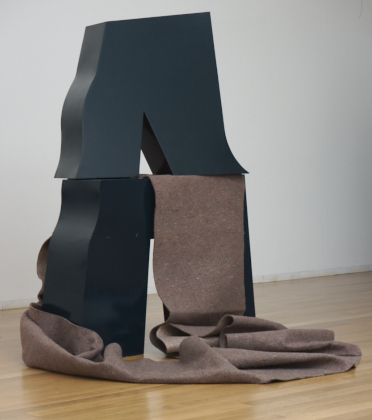
"A" grande
João Vieira (Vidago, Portugal, 1934 - Lisboa, Portugal, 2009)
Car paint on wood and felt
250 x 140 x 60 cm
Coll. Fundação de Serralves - Museu de Arte Contemporânea, Porto, Portugal. Acquisition 1999

Sem título
Júlia Ventura (Lisboa, Portugal, 1952)
B/w photograph
78.5 x 107 cm
Coll. Fundação de Serralves - Museu de Arte Contemporânea, Porto, Portugal. Acquisition 2005
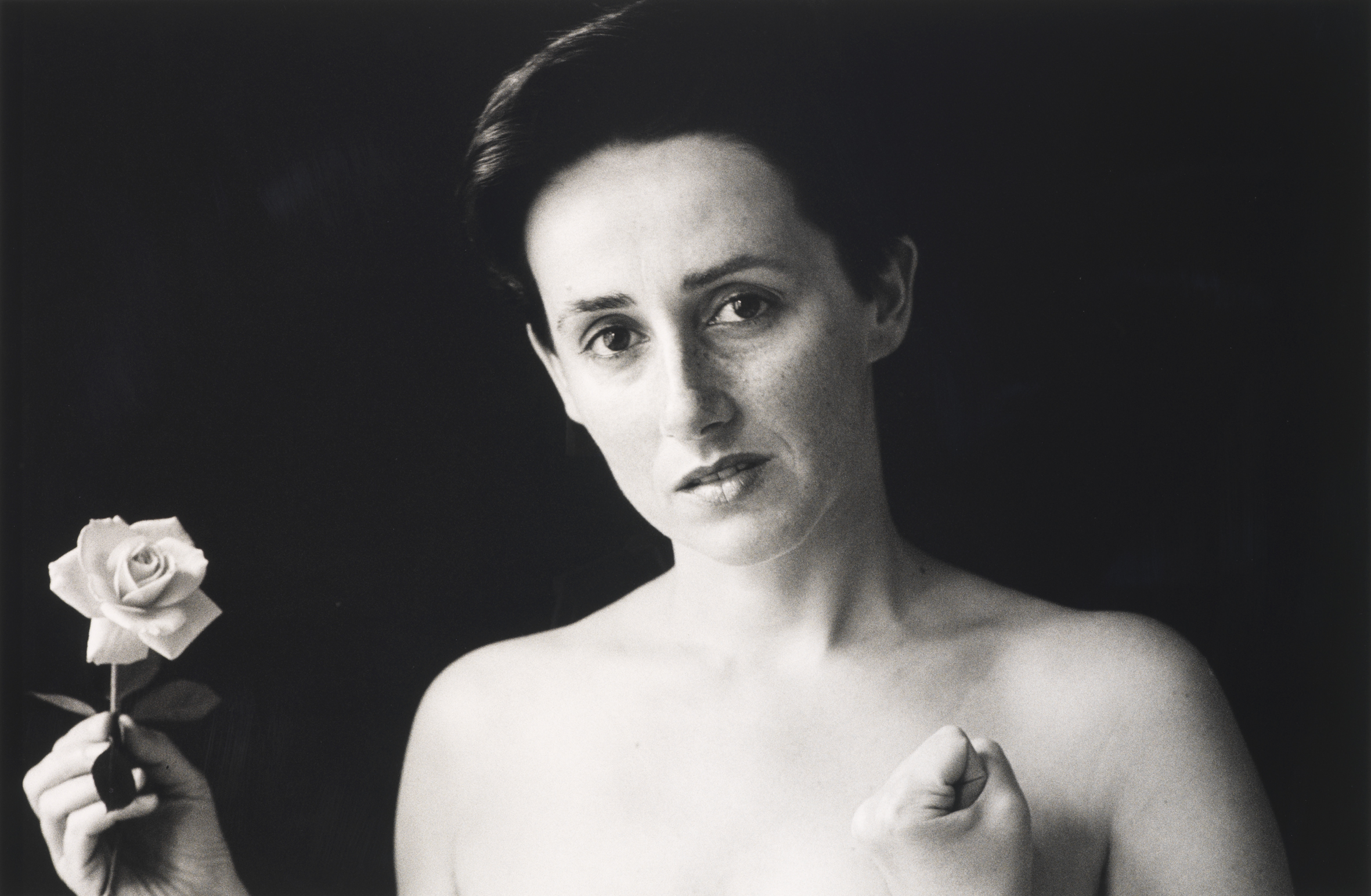
Sem título
Júlia Ventura (Lisboa, Portugal, 1952)
B/w photograph
78.5 x 107 cm
Coll. Fundação de Serralves - Museu de Arte Contemporânea, Porto, Portugal. Acquisition 2005
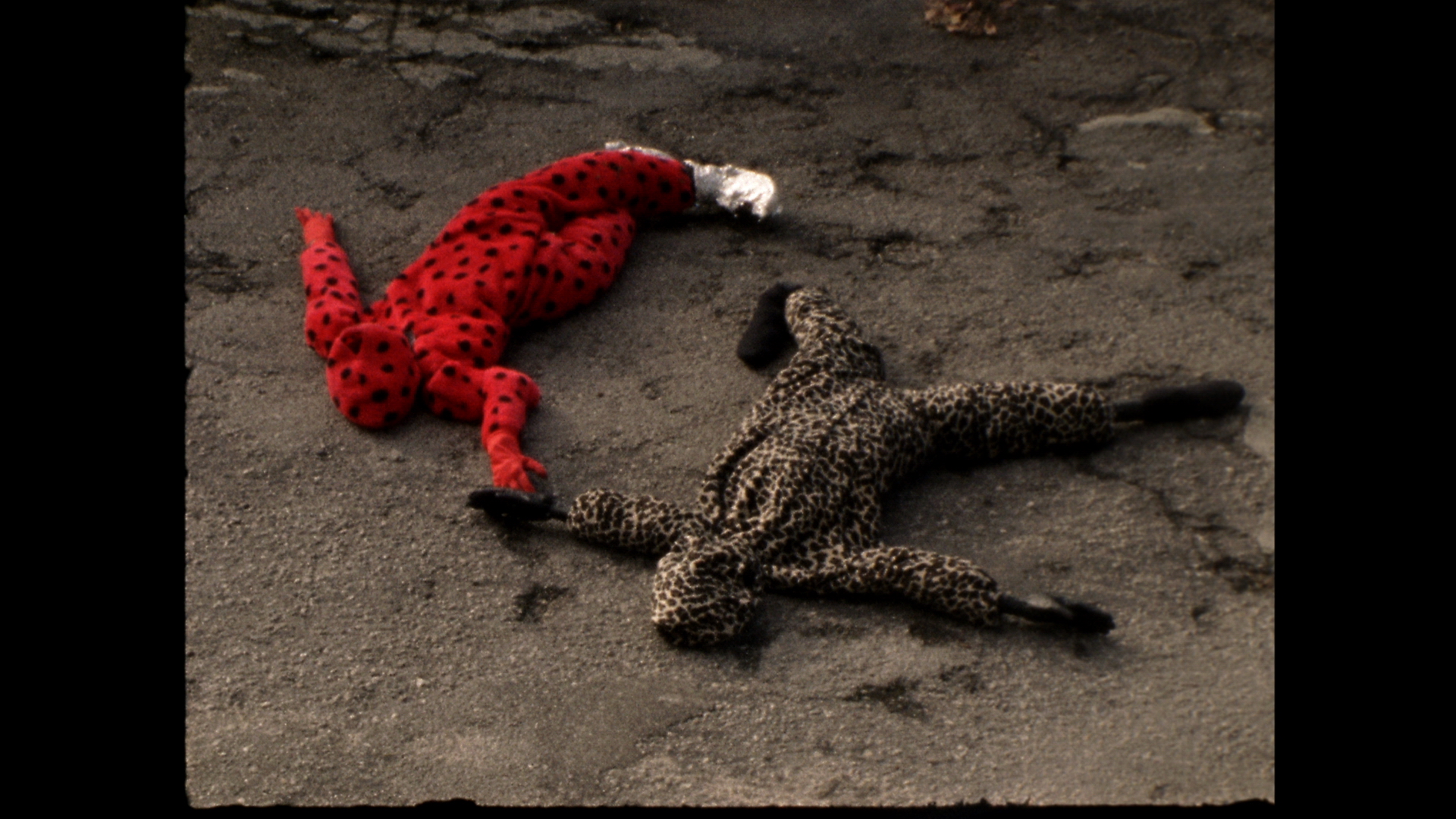
Avesso
!VON CALHAU! (, , 0)
Film 16 mm transferred to video, colour, sound, 19'15''
Coll. Fundação de Serralves - Museu de Arte Contemporânea, Porto. Work comissioned for the 2011 edition of the Sonae|Serralves Project. Acquisition 2012
!Von Calhau! is an artist duo composed of Marta Baptista and João Alves. Baptista and Alves produce music, perform at galleries, and conceive and make silent 16 mm films for which they often provide live musical accompaniment. Their films narrate stories of paranormal and esoteric activities related to the psychedelic, the occult and mysticism. In 'Avesso' [Reverse], the artists present themselves as second-rate professionals, dressed in animal-print suits, emphasizing the position of the amateur, and the deliberately improvised. This concern with energy liberation is visible in the artists’ interest in volcanoes and quarry blasts. In this film, !Von Calhau! confront the viewer with melodramatic and delirious acts, trances, and expressions of esotericism. For this pair, realism is tiresome.
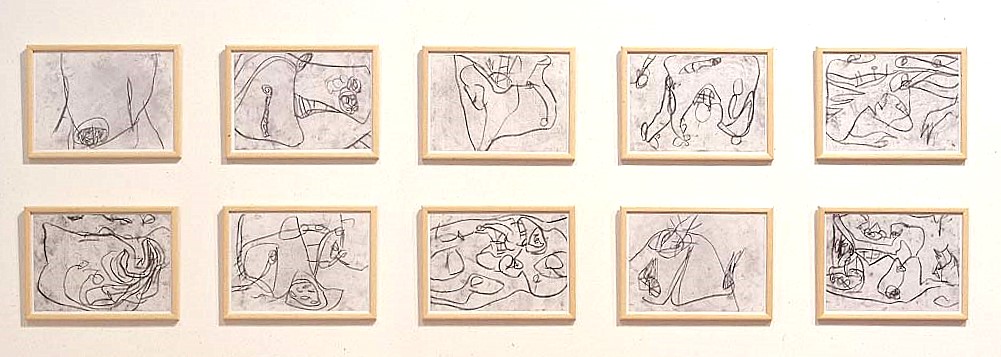
Sem título
Pedro Sousa Vieira (Porto, Portugal, 1963)
Charcoal on paper (10 elements)
21 x 29.5 cm (each)
Coll. Fundação de Serralves - Museu de Arte Contemporânea, Porto, Portugal. Acquisition 1996

Joseph Beuys in memoriam
Andy Warhol (Pittsburgh, EUA, 1928 - Nova Iorque, EUA, 1987)
Silkscreen on paper
81.3 x 61 cm
Coll. Portuguese State Secretariat of Culture, long-term loan to Fundação de Serralves - Museu de Arte Contemporânea, Porto. Deposit 1990
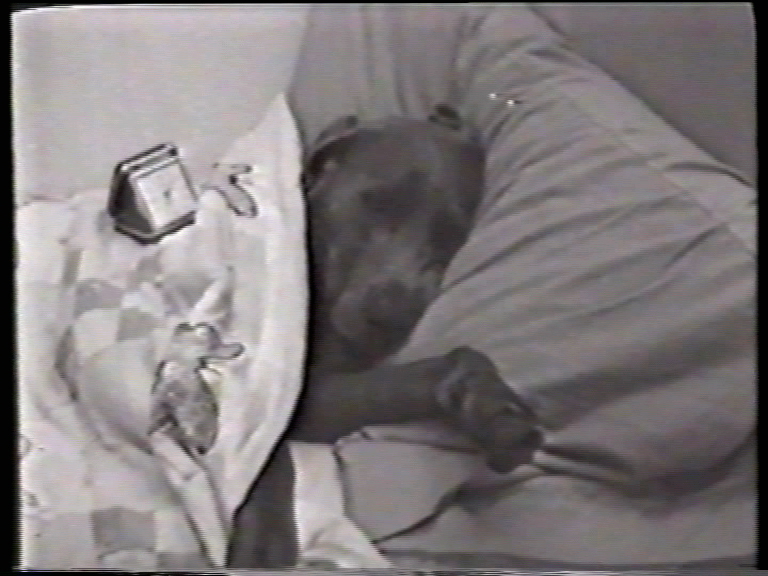
Wegman Reel 4
William Wegman (Holyoke, EUA, 1943)
Video, b/w, sound, PAL, 27'50"
Coll. Fundação de Serralves - Museu de Arte Contemporânea, Porto, Portugal. Acquisition 1999
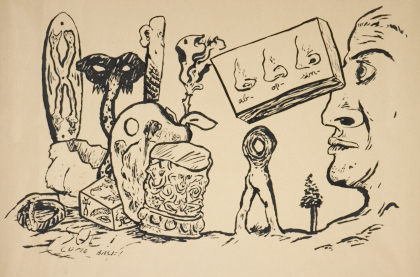
Sem título
Manuel João Vieira (Lisboa, Portugal, 1962)
Indian ink on paper
100 x 150 cm A altura é irregular
Coll. of the artist, long-term loan to Fundação de Serralves - Museu de Arte Contemporânea, Porto. Deposit 2004
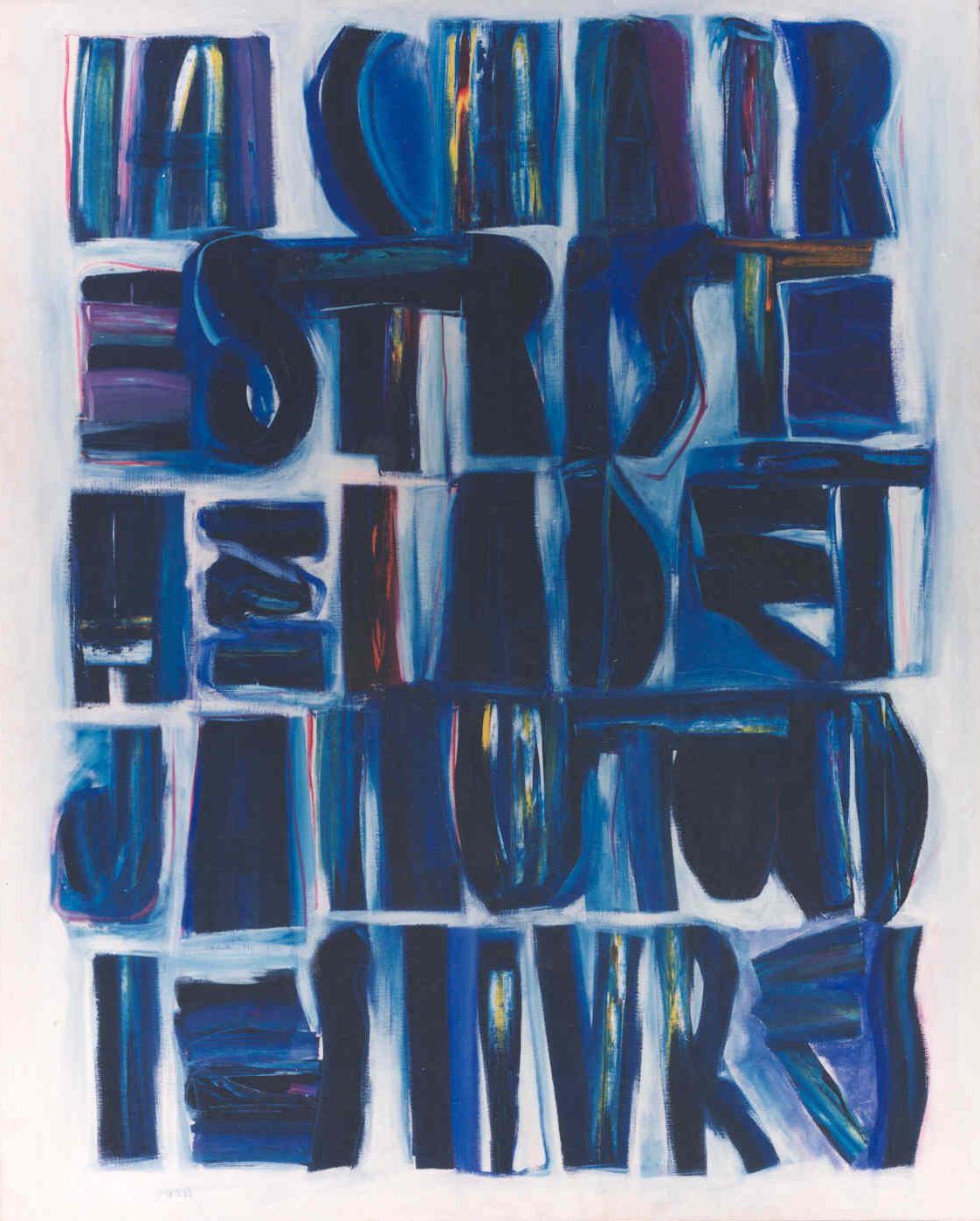
Sem título (La Chair est Triste)
João Vieira (Vidago, Portugal, 1934 - Lisboa, Portugal, 2009)
Oil on canvas
161.4 x 129.5 cm
Coll. Portuguese State Secretariat of Culture, long-term loan to Fundação de Serralves - Museu de Arte Contemporânea, Porto. Deposit 1990
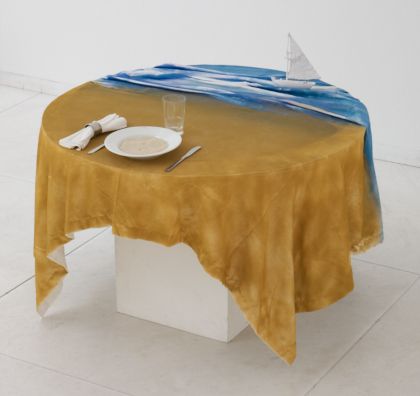
Mesa-Paisagem
Ana Vieira (Coimbra, Portugal, 1940 - Lisboa, Portugal, 2016)
Wood table, spray painting on fabric, metal, ceramic, fabric and objects (1 plate, cutlery, ring napkins, napkin, sand, boat)
94 x 110 x 110 cm
Coll. Fundação de Serralves - Museu de Arte Contemporânea, Porto, Portugal. Acquisition 1998
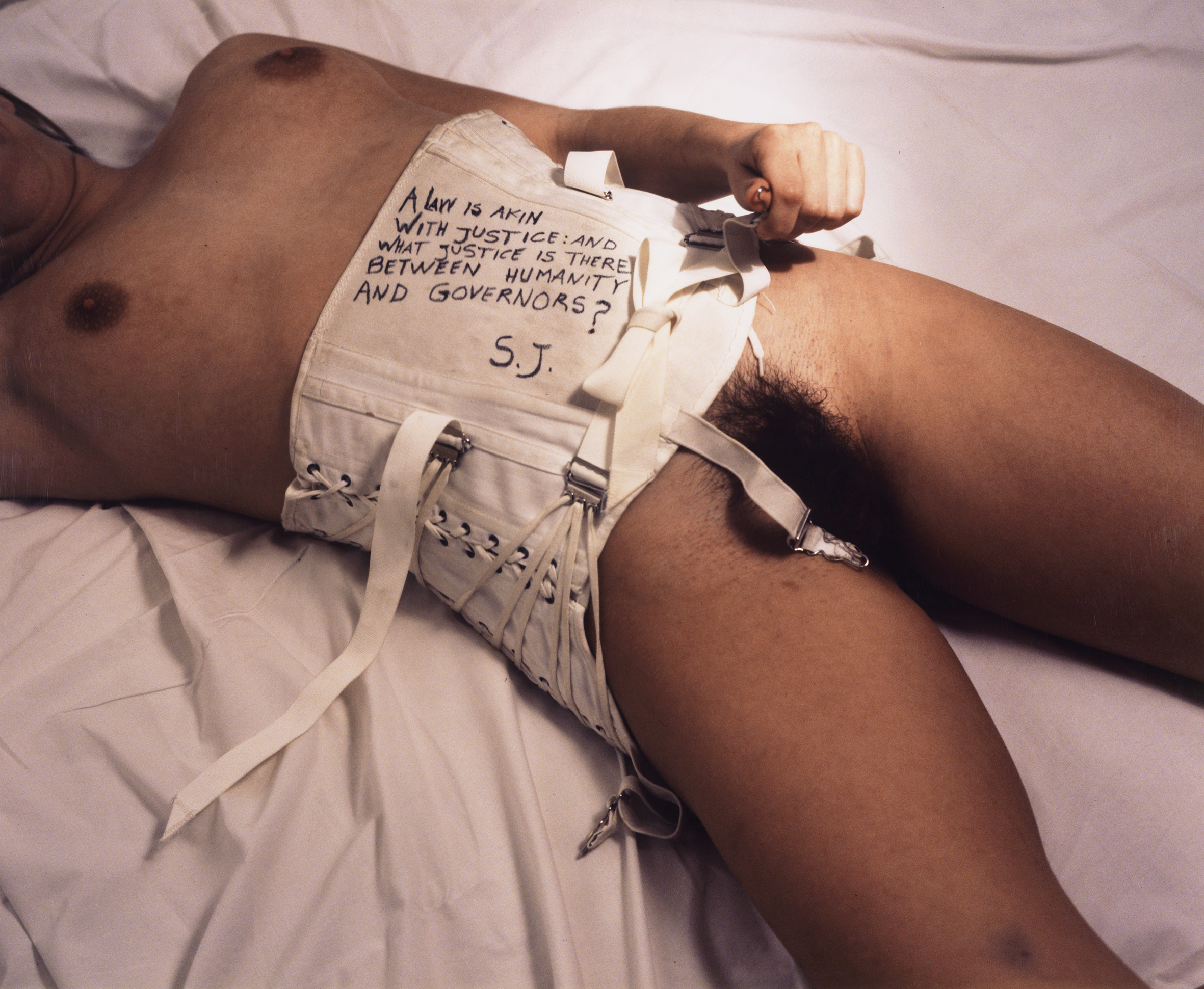
Sem título, da série "A mulher e a política"
Carlos Vidal (Lisboa, Portugal, 1964)
Colour photograph
150 x 178 cm
Private collection, long-term loan to Fundação de Serralves - Museu de Arte Contemporânea, Porto. Deposit 2003

Sem título, da série "A Pintura e a Política" (Conversando com Gehard Richter)
Carlos Vidal (Lisboa, Portugal, 1964)
Colour photograph (diptych)
150 x 178 cm (each)
Private collection, long-term loan to Fundação de Serralves - Museu de Arte Contemporânea, Porto. Deposit 2003

Aquário
Ana Vieira (Coimbra, Portugal, 1940 - Lisboa, Portugal, 2016)
Acrylic, wood, painted grid, plastic, nylon wire, metal
103.2 x 70.5 x 16 cm
Coll. Portuguese State Secretariat of Culture, long-term loan to Fundação de Serralves - Museu de Arte Contemporânea, Porto. Deposit 1990
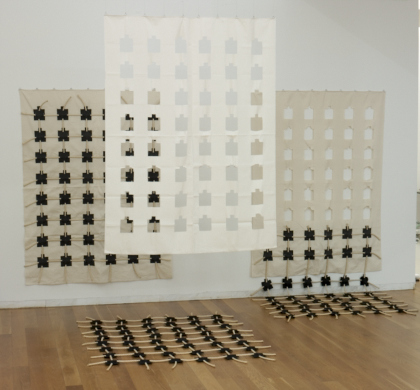
(Des)Construções
Pires Vieira (Porto, Portugal, 1950)
Enamel on raw cotton, sisal rope, cotton canvas (4 elements)
Dimensions variable
Coll. Fundação de Serralves - Museu de Arte Contemporânea, Porto, Portugal. Acquisition 1999
The simple geometric forms of '(Des)Construções' [(De)Constructions] reveal the artist’s interest in the study of the essential structures of painting in order to deconstruct its constitutive elements: colour, forms, perspective, the figure-background relationship, seriality and repetition. The cotton canvases, on which a small, enamel painted square crossed by sisal rope is repeated, are shown unframed, simply hanging or placed on the floor. Pires Vieira separates the painting from the wall and gives it a three-dimensional quality, a condition that questions the boundaries between painting and sculpture. After studying architecture and urbanism in Paris and Vincennes, Pires Vieira’s early work was produced under the influence of American minimalism and the French Support-Surface movement, as the artist researched painting as an objective and material thing. From the 1990s onwards the researching of issues linked to subjectivity, to lived experience and to memory took on an importance that nevertheless includes a rigorous, analytical approach based on the surveying of forms, the simplifying of the figure and the systematic fragmentation of the body.
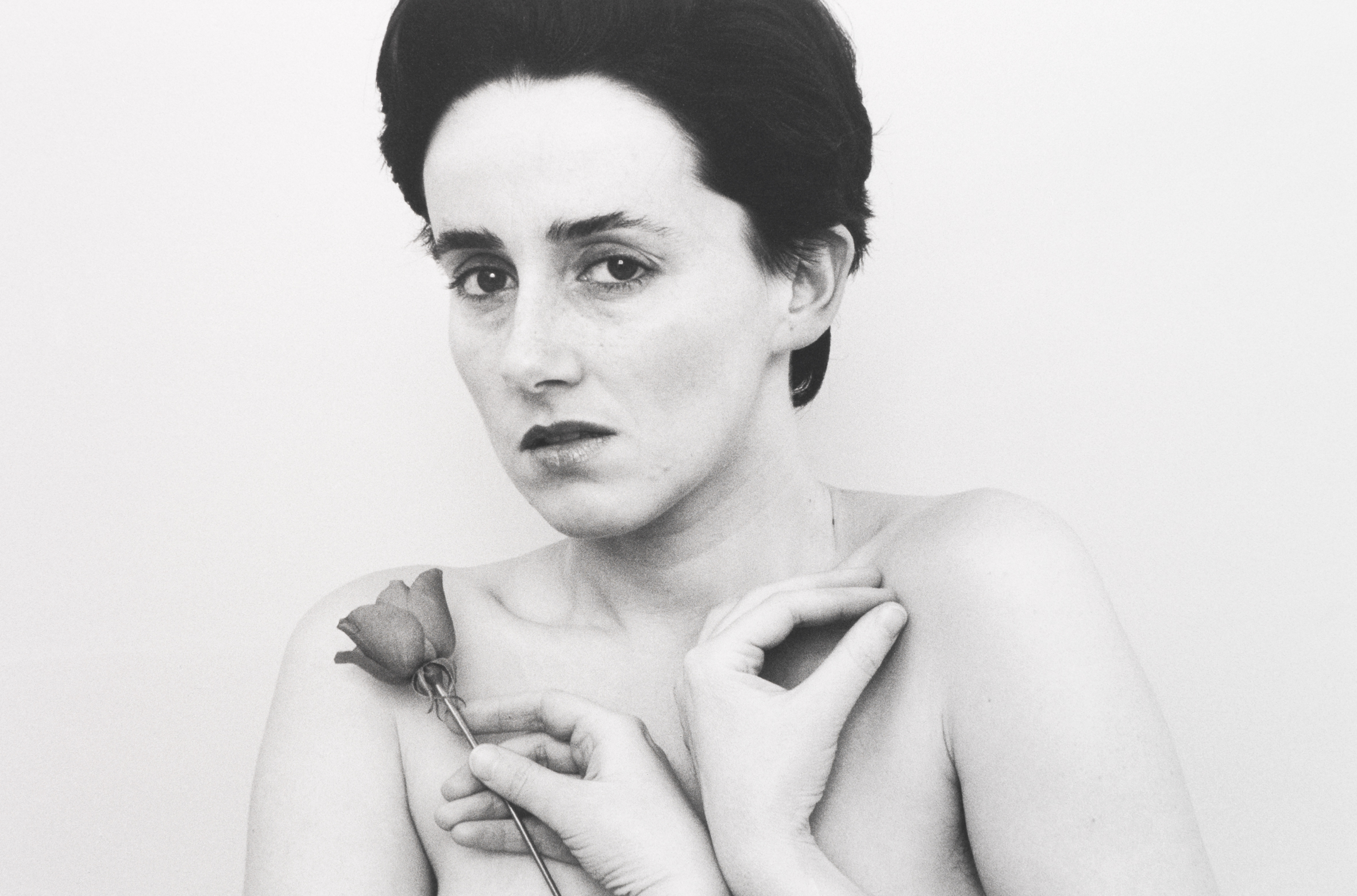
Sem título
Júlia Ventura (Lisboa, Portugal, 1952)
B/w photograph
78.5 x 107 cm
Coll. Fundação de Serralves - Museu de Arte Contemporânea, Porto, Portugal. Acquisition 2005
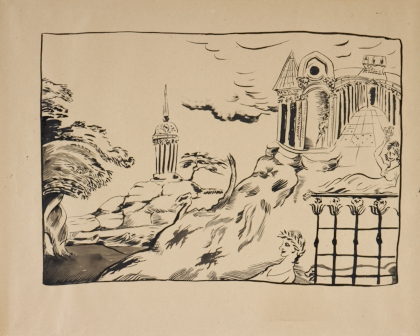
Sem título
Manuel João Vieira (Lisboa, Portugal, 1962)
Indian ink on paper
100 x 126 cm
Coll. of the artist, long-term loan to Fundação de Serralves - Museu de Arte Contemporânea, Porto. Deposit 2004

Ambiente
Ana Vieira (Coimbra, Portugal, 1940 - Lisboa, Portugal, 2016)
Tubular metalic structure, nylon wesh with spray painting, carpet, furniture, lamp, personal objects, cotton, earth, artificial plant, flowers and fruits
250 x 900 x 340 cm
Coll. Fundação de Serralves - Museu de Arte Contemporânea, Porto, Portugal. Acquisition 2002
Ana Vieira belongs to the first generation of Portuguese artists who, during the 1960s, challenged the central place of traditional media of painting and sculpture. Early in her career, the artist began to focus on domestic space, and the permeability between inside and outside that is inherent to it, as the main theme of her work. Vieira’s objects and installations question concepts and stereotypes around the role of the house. In order to be fully experienced, they coax the viewer to move in the museum and gallery space, thus countering his/her traditionally passive attitude.'Ambiente' belongs to a series of three environments that the artist showed between 1971 and 1973. The first, titled 'Sala de jantar (Ambiente)' [Dining Room (Environment)] was exhibited at Galeria Quadrante, in Lisbon; the second' (Ambiente)' was presented in 1972 at Sociedade Nacional de Belas-Artes, also in Lisbon; and the third - the one at hand - was shown for the first time in 1972, at Galeria Ogiva, in Óbidos, having been modified in the following year for an exhibition at Ar.Co, in Lisbon. The large scale, the use of translucent materials (curtains and mesh) and the interdiction of physical access into the objects they guard - namely furniture, and pieces from the heavy tradition of the fine-arts, such as a Venus de Milo and still lifes functioning as signs of domesticity - are some of the features shared by the group of works in this series. According to Vieira, large scale was essential to also involve the body of the viewer, to make him/her see with the whole body.Curtains, on which are painted partitions, a door and a window, delimit an interior space, which a few pieces of furniture (a writing desk, a chaise-longue, a column for plants, a hanger and a lamp) and decorative and personal objects configure as a dwelling space. Cotton clouds hanging from the ceiling, apples scattered on the ground, flowers and a small pile of earth sharing the space with them create a transfusion between inside and outside, which the simulated character of the door and window counters. If, as stated by fellow artist Salette Tavares, ‘the real house in which we live has windows, which bring the outside inside, and doors, which allow us in laden with the outside, and let us out laden with the inside laced with pieces of the outside’, in this one the umbrella on the hanger, a sign of traffic between outside and inside, is as prevented from leaving as the viewer is from entering.Only the curtains-walls allow viewers to glimpse the domestic interior, from which they are excluded, as the object-environment can only be penetrated visually and, even then, not fully. In the space of the museum or gallery viewers are permanently exposed to other viewers, all of them voyeurs, in vain trying to see in. As justly remarked by Portuguese author Maria Filomena Molder, one cannot play, one is not asked to participate. Ambiente excludes the gaze; if it is a house, it is an impertinent house.
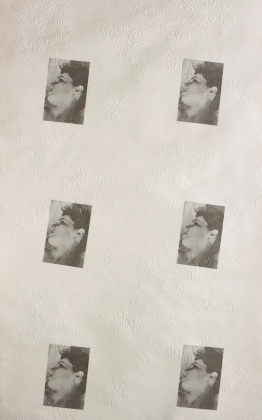
Sem título
Júlia Ventura (Lisboa, Portugal, 1952)
Wallpaper
Dimensions variable
Coll. Fundação de Serralves - Museu de Arte Contemporânea, Porto, Portugal. Acquisition 2005

Sem título
Manuel João Vieira (Lisboa, Portugal, 1962)
Indian ink on paper
100 x 523 cm
Coll. of the artist, long-term loan to Fundação de Serralves - Museu de Arte Contemporânea, Porto. Deposit 2004

Sem título
Manuel João Vieira (Lisboa, Portugal, 1962)
Indian ink on paper
100 x 501 cm
Coll. of the artist, long-term loan to Fundação de Serralves - Museu de Arte Contemporânea, Porto. Deposit 2004
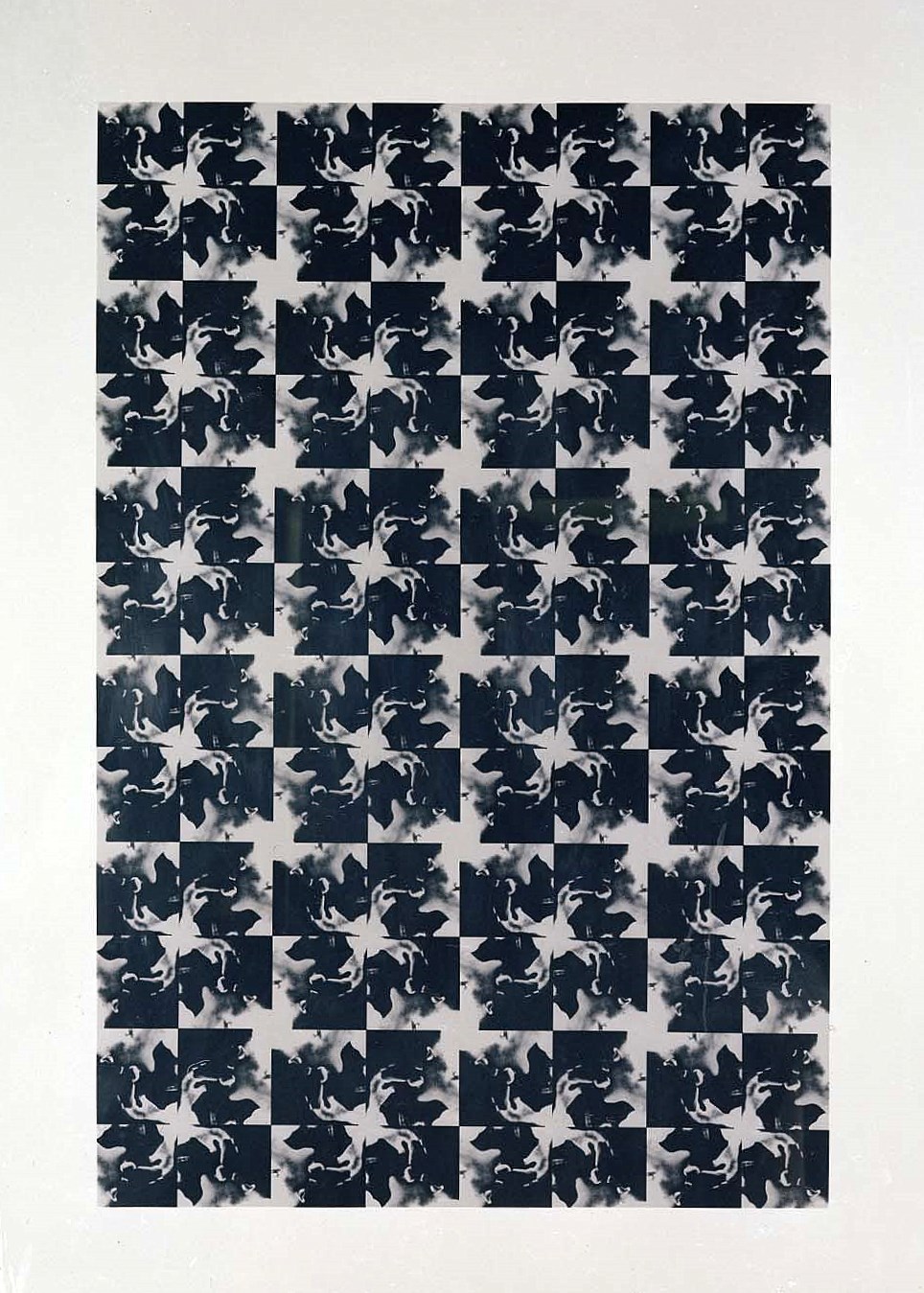
Sem título
Júlia Ventura (Lisboa, Portugal, 1952)
B/w photograph
175 x 123 cm
Coll. Fundação de Serralves - Museu de Arte Contemporânea, Porto, Portugal. Acquisition 1993

Conhece a Via Láctea?
Joaquim Pinto Vieira (Avintes, Portugal, 1946)
Synthetic enamel on polyethylene
140 x 140 x 7.5 cm
Coll. Fundação de Serralves - Museu de Arte Contemporânea, Porto, Portugal. Donation by Ângelo de Sousa 2000
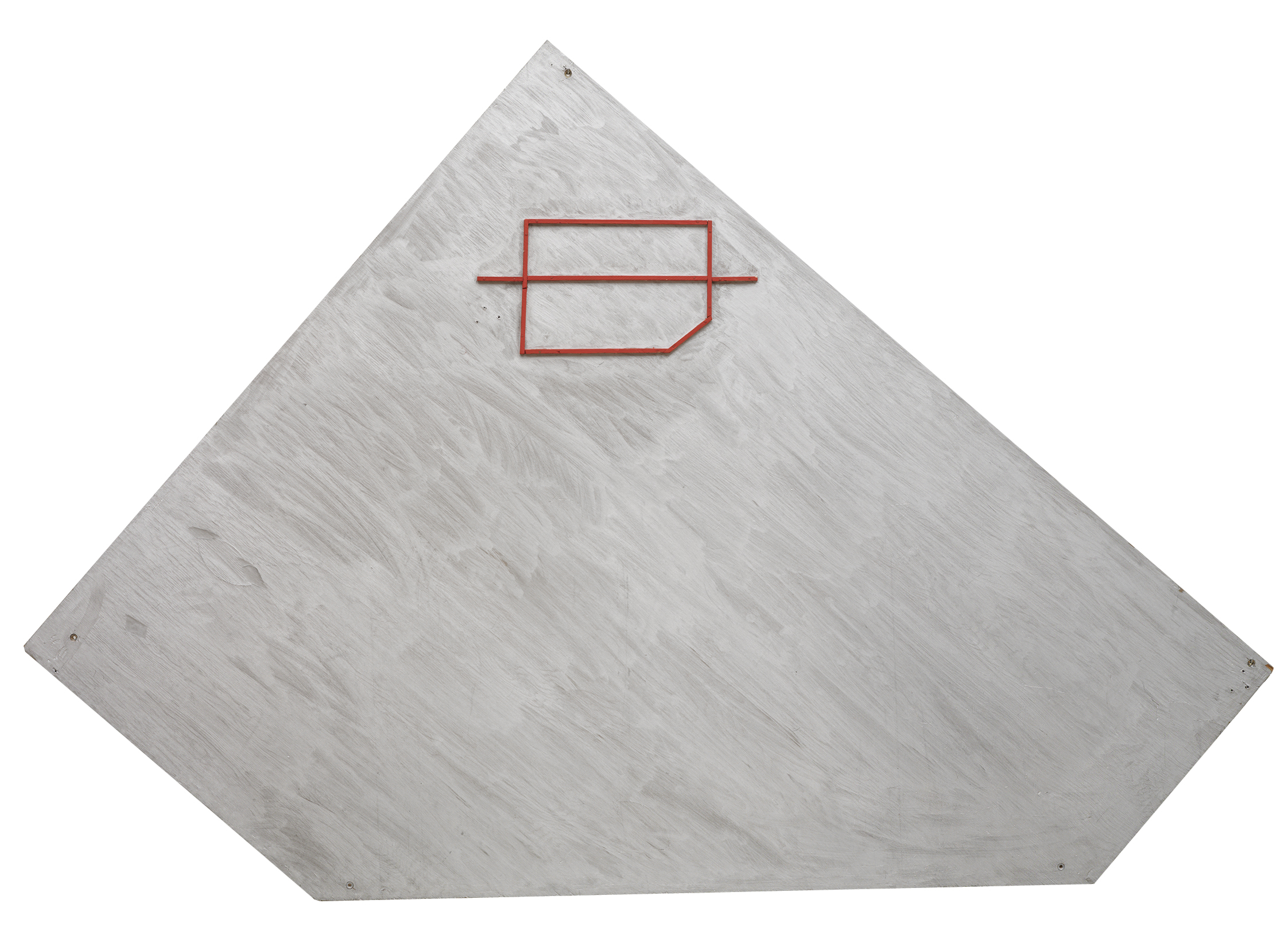
The Level of Water
Lawrence Weiner (Bronx, EUA, 1942)
Plywood, balsa wood, paint
130 x 198 cm Para embalagem as medidas são: 123 x 147,5 cm
Coll. Fundação de Serralves - Museu de Arte Contemporânea, Porto, Portugal. Acquisition 1998
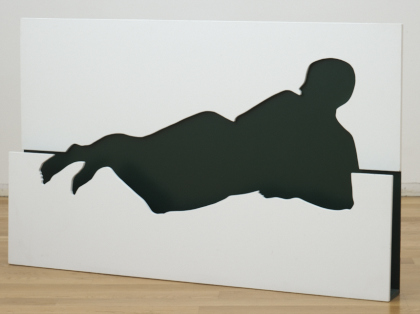
Sem título
Ana Vieira (Coimbra, Portugal, 1940 - Lisboa, Portugal, 2016)
Enamel on wood
113 x 183 x 16 cm
Coll. Fundação de Serralves - Museu de Arte Contemporânea, Porto, Portugal. Acquisition 1998
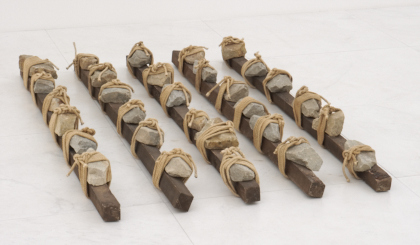
Sem título
Pires Vieira (Porto, Portugal, 1950)
Stone, wood, rope
20 x 272 x 220 cm
Coll. Fundação de Serralves - Museu de Arte Contemporânea, Porto, Portugal. Acquisition 1999

Sem título
Manuel João Vieira (Lisboa, Portugal, 1962)
Indian ink on paper
100 x 551 cm
Coll. of the artist, long-term loan to Fundação de Serralves - Museu de Arte Contemporânea, Porto. Deposit 2004
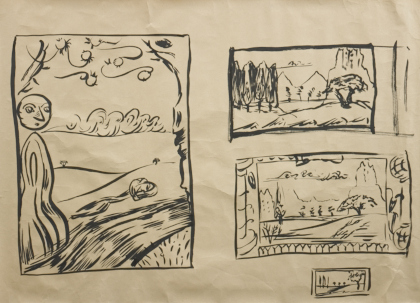
Sem título
Manuel João Vieira (Lisboa, Portugal, 1962)
Indian ink on paper
100 x 140 cm
Coll. of the artist, long-term loan to Fundação de Serralves - Museu de Arte Contemporânea, Porto. Deposit 2004

Sem título
Manuel João Vieira (Lisboa, Portugal, 1962)
Indian ink on paper
100 x 408.5 cm A altura é irregular
Coll. of the artist, long-term loan to Fundação de Serralves - Museu de Arte Contemporânea, Porto. Deposit 2004

Corredor
Ana Vieira (Coimbra, Portugal, 1940 - Lisboa, Portugal, 2016)
Wood, aluminum, fabric
285 x 300 x 2313 cm
Coll. of the artist, long-term loan to Fundação de Serralves - Museu de Arte Contemporânea, Porto. Deposit 1999
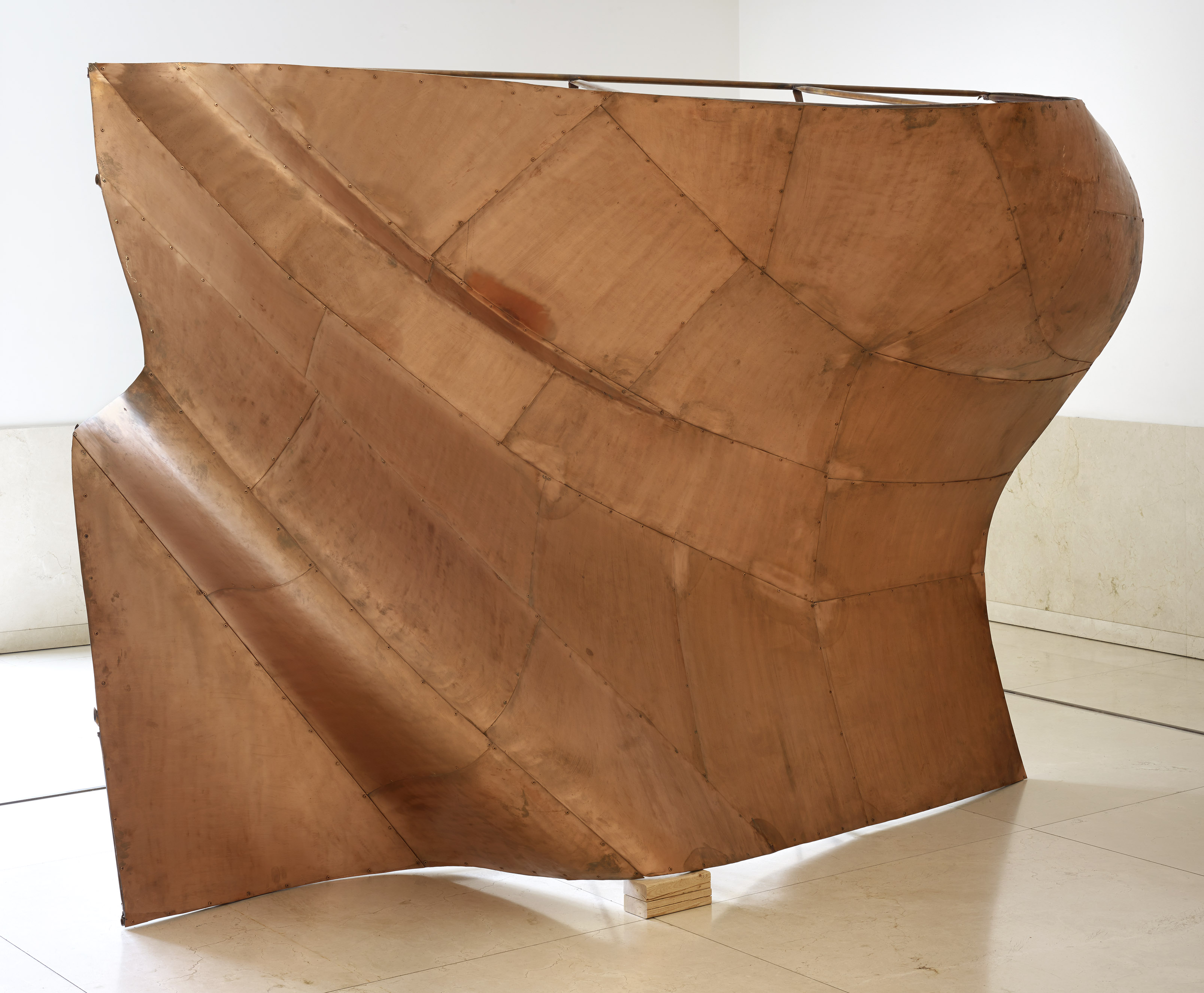
We the people (detail)
Danh Võ (Bà Ria, Vietname, 1975)
Copper
202 x 300 x 80 cm
Coll. Fundação de Serralves - Museu de Arte Contemporânea, Porto, Portugal. Acquisition 2013
The circulation of ideas and ideologies and the questioning of authorship and authenticity are features of Danh Võ’s subtle yet eloquent work, where migration and cultural displacement are recurring themes.We the People (detail) - whose title quotes the first three words of the Constitution of the United States - is part of a project about the Statue of Liberty that began in 2010. Impressed by the fragility of the copper sheet surface covering the monument’s steel structure, Võ commissioned a 1:1 scale replica of the cladding. The purpose was not to build a new statue but, in a gesture of appropriation, to reconstruct its more than 250 individual elements and to disperse them across different collections throughout the world. Võ’s fragments underscore the abstract nature of the universal symbolism of the statue and invite us to experience this world famous icon on a human scale, and to reflect on the meaning of liberty from multiple perspectives.
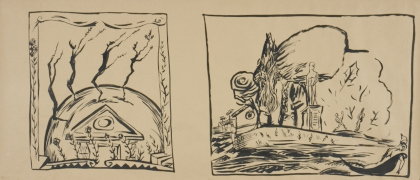
Sem título
Manuel João Vieira (Lisboa, Portugal, 1962)
Indian ink on paper
100 x 232.5 cm
Coll. of the artist, long-term loan to Fundação de Serralves - Museu de Arte Contemporânea, Porto. Deposit 2004
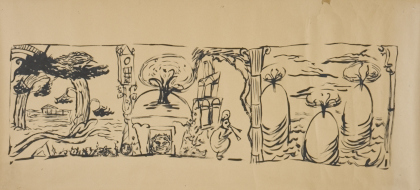
Sem título
Manuel João Vieira (Lisboa, Portugal, 1962)
Indian ink on paper
100 x 223 cm
Coll. of the artist, long-term loan to Fundação de Serralves - Museu de Arte Contemporânea, Porto. Deposit 2004

Cruz I
Joaquim Pinto Vieira (Avintes, Portugal, 1946)
Enamel paint on Tola wood (triptych)
219.5 x 360 x 10 cm
Coll. Museu Nacional de Soares dos Reis, long-term loan to Fundação de Serralves - Museu de Arte Contemporânea de Serralves, Porto. Deposit 1990
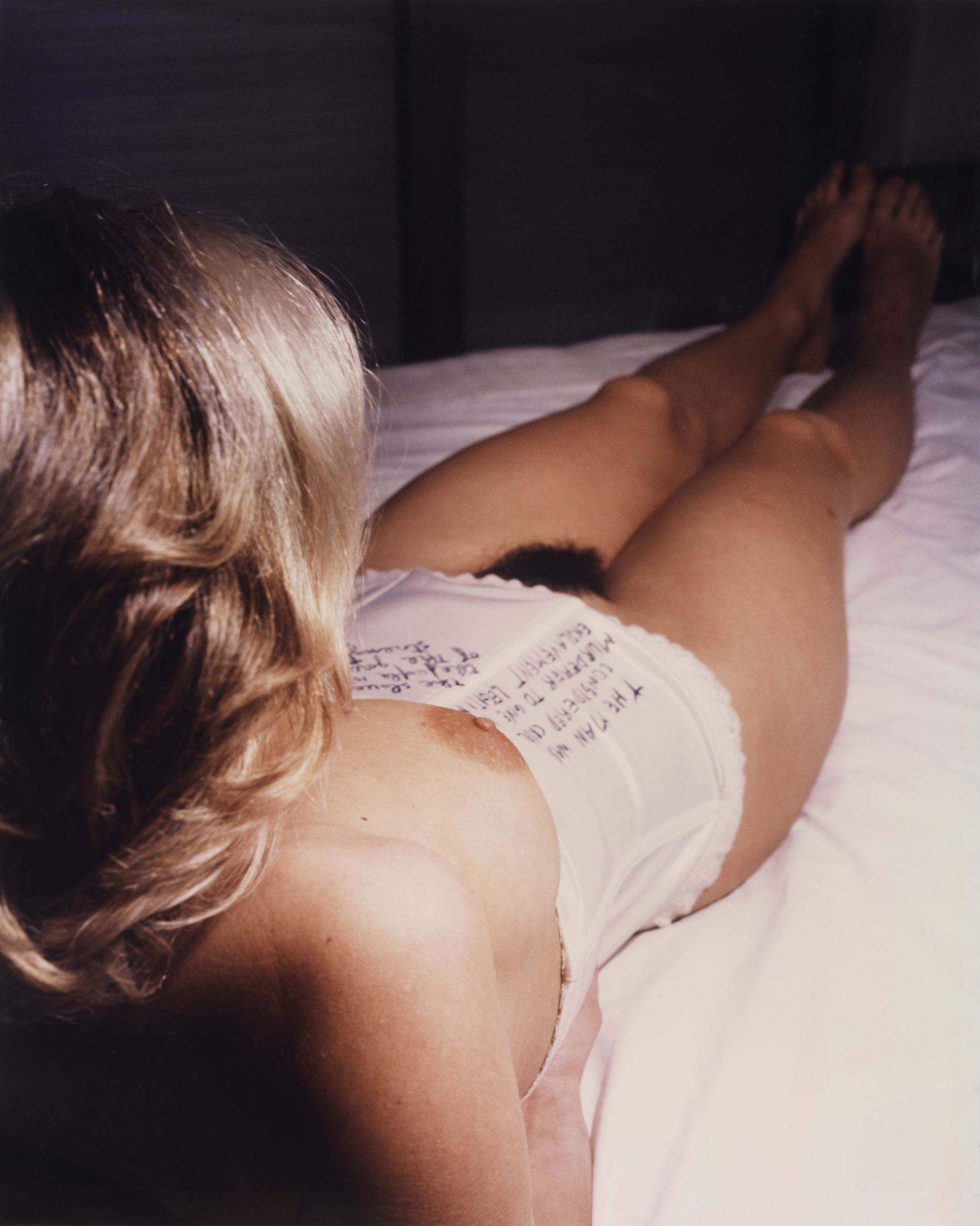
Sem título, da série "A Pintura e a Política" (Conversando com Gehard Richter)
Carlos Vidal (Lisboa, Portugal, 1964)
Colour photograph
170 x 140 cm
Coll. Fundação de Serralves - Museu de Arte Contemporânea, Porto, Portugal. Acquisition 2002

A First Quarter
Lawrence Weiner (Bronx, EUA, 1942)
Video (Betacam), b/w, silent, PAL, 85’
Coll. Fundação de Serralves - Museu de Arte Contemporânea, Porto, Portugal. Acquisition 1999

Sem título
Manuel João Vieira (Lisboa, Portugal, 1962)
Indian ink on paper
100 x 109 cm As dimensões são irregulares
Coll. of the artist, long-term loan to Fundação de Serralves - Museu de Arte Contemporânea, Porto. Deposit 2004
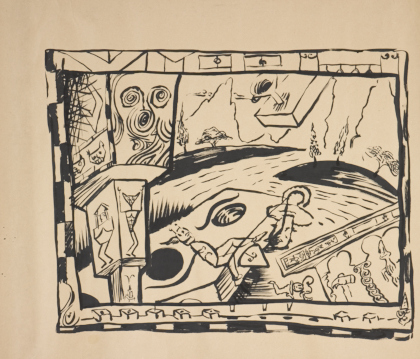
Sem título
Manuel João Vieira (Lisboa, Portugal, 1962)
Indian ink on paper
100 x 117 cm
Coll. of the artist, long-term loan to Fundação de Serralves - Museu de Arte Contemporânea, Porto. Deposit 2004
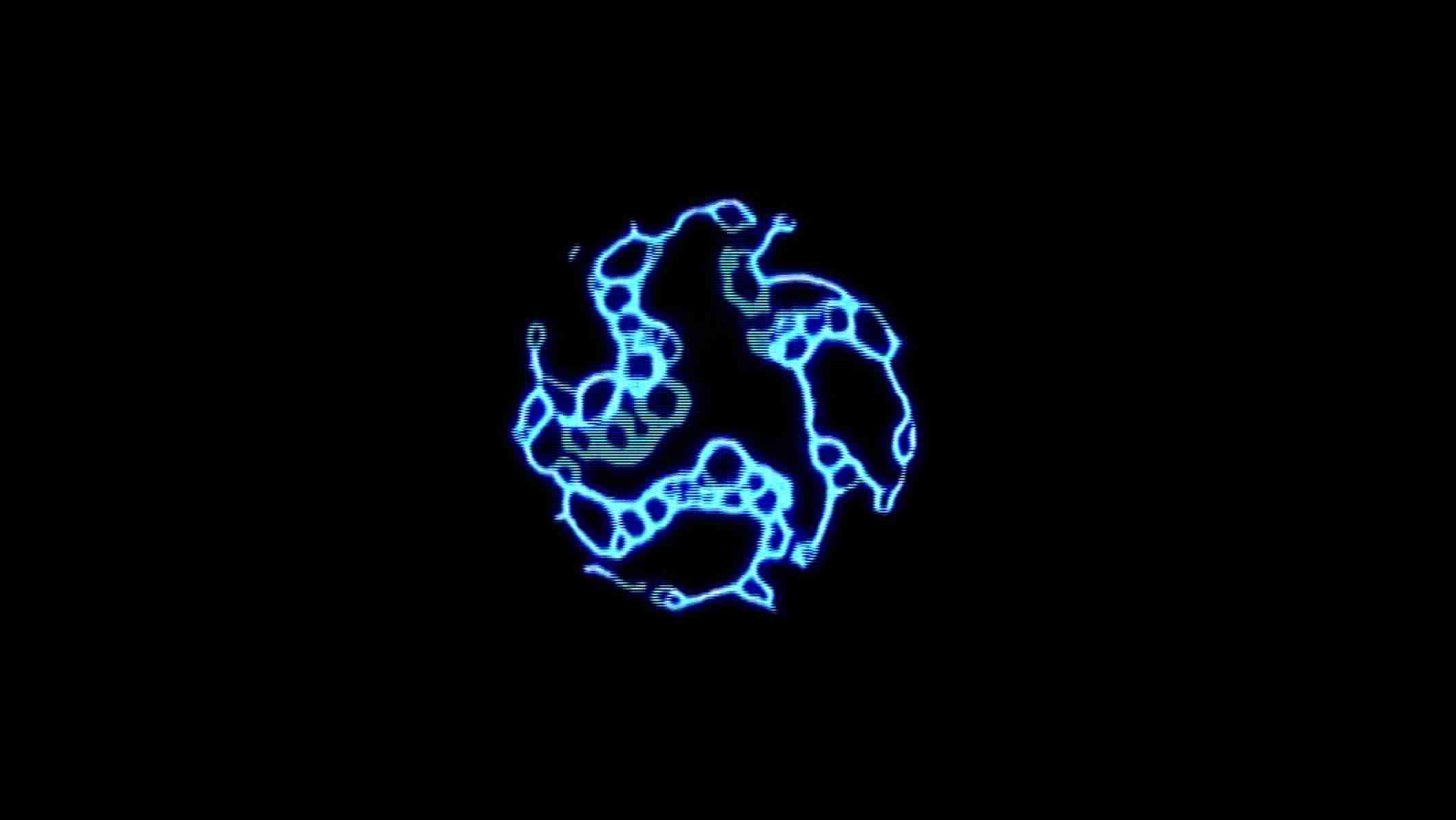
Blue Motion video series - Feedback IV
Ruben Verdadeiro (Açores, Portugal, 1974)
Mini-DV video transferred to DVD, PAL 16:9, colour, silent, 08'17", loop. Ed. 1/3 + 1 A.P.
Coll. Fundação de Serralves - Museu de Arte Contemporânea, Porto, Portugal. Acquisition 2007
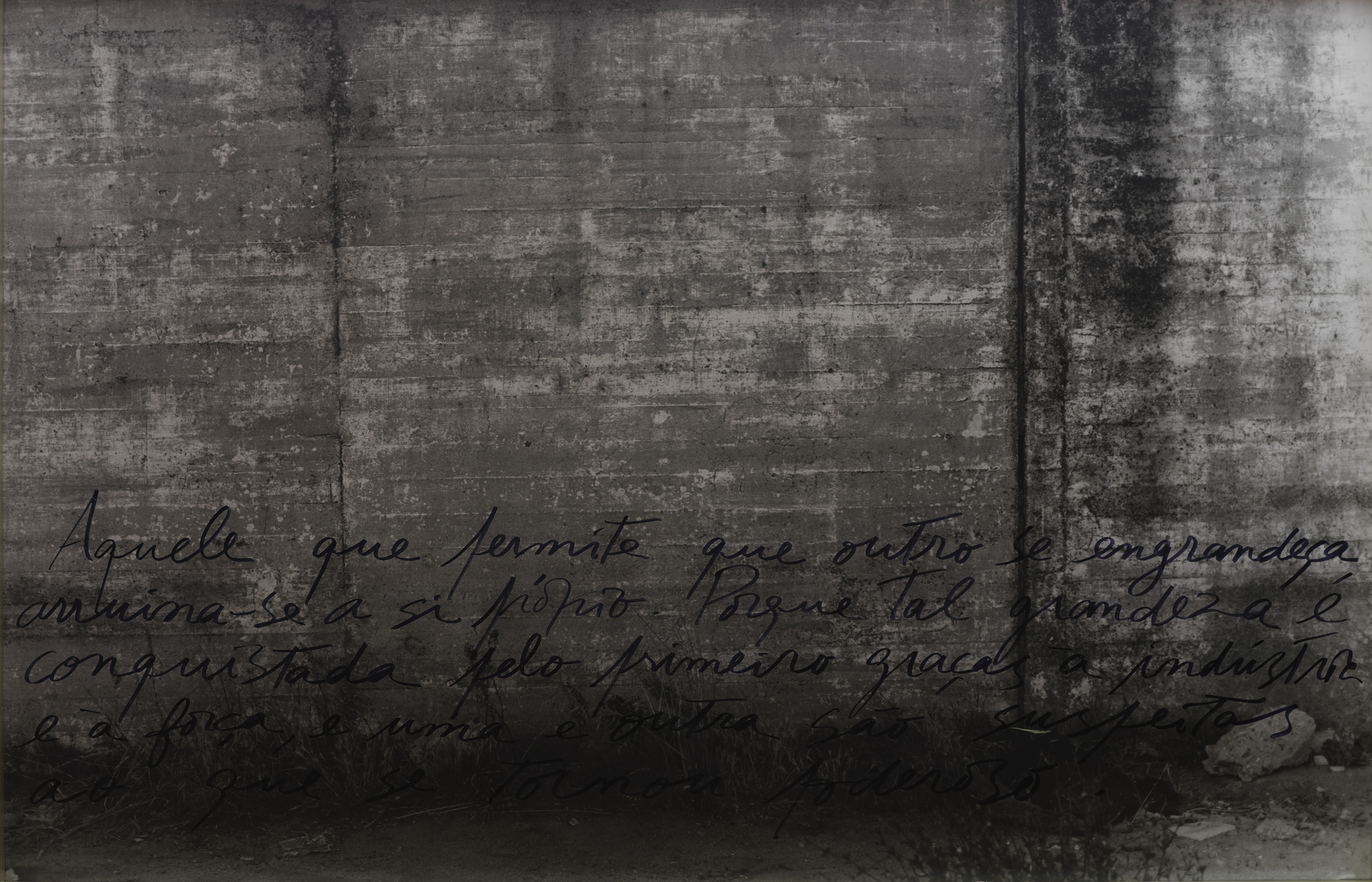
Sem título, da série "A Fotografia e a Política" (sobre a fortuna de Maquiavel)
Carlos Vidal (Lisboa, Portugal, 1964)
B/w photograph
123.5 x 186.5 cm
Coll. Fundação de Serralves - Museu de Arte Contemporânea, Porto, Portugal. Acquisition 2002
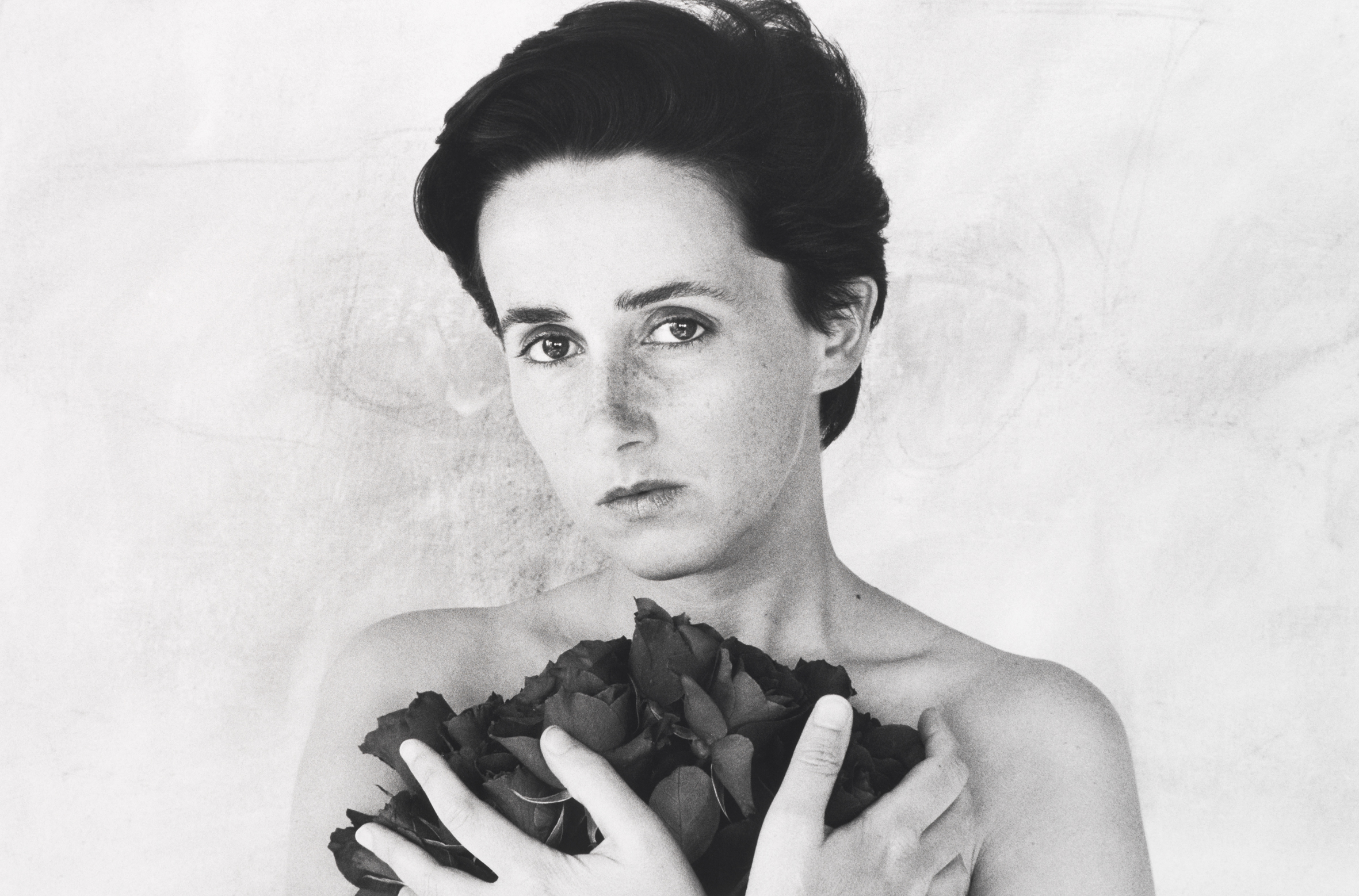
Sem título
Júlia Ventura (Lisboa, Portugal, 1952)
B/w photograph
78.5 x 107 cm
Coll. Fundação de Serralves - Museu de Arte Contemporânea, Porto, Portugal. Acquisition 2005
